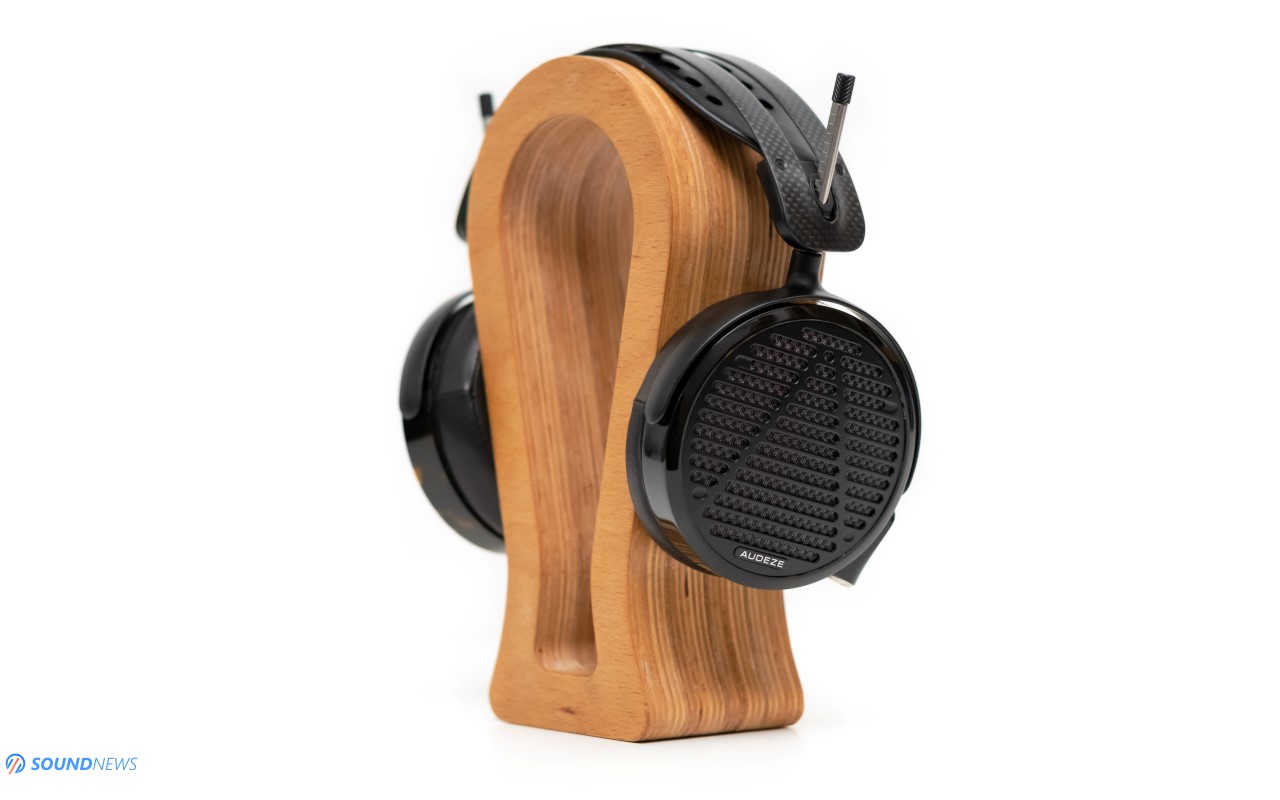Audeze LCD-5 – A Statement Review
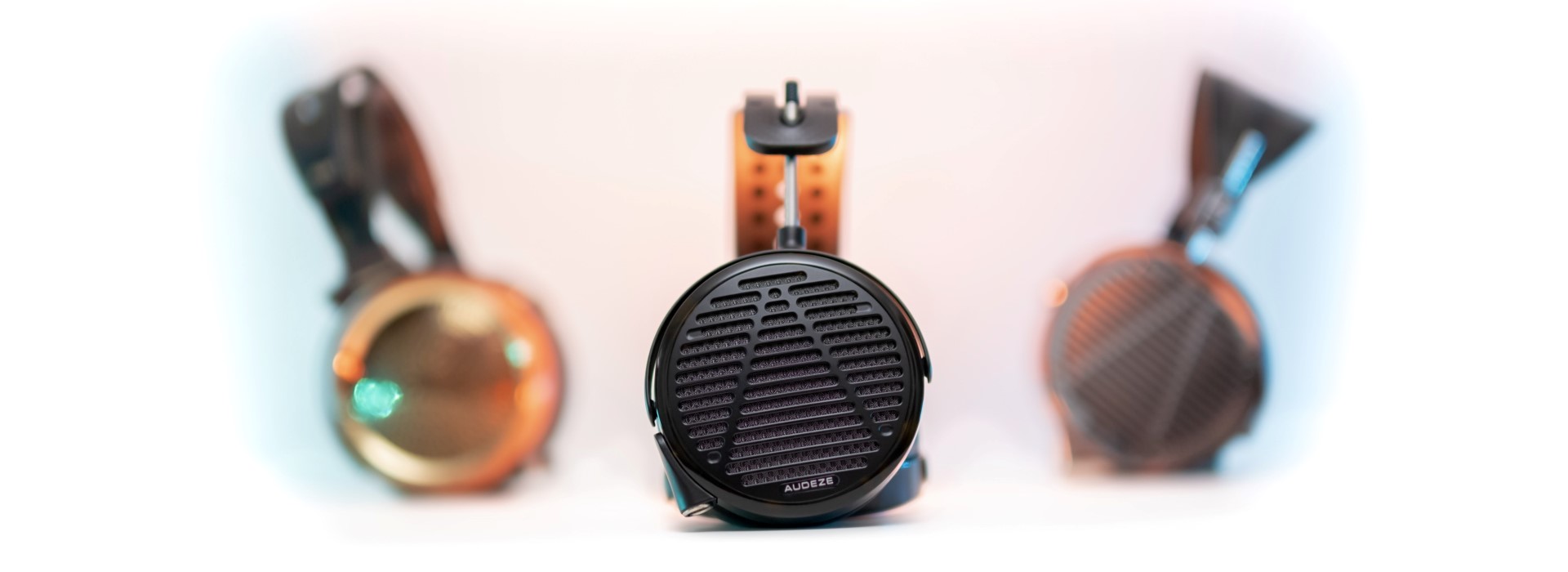
My Video Review:
Planar-magnetic technology dates all the way back to 1970-ties, where brands as Wharfedale, Fostex, Sansui, Aiwa, Yamaha, Audio-Technica and NAD started paving grounds for what later would be known as planar headphones. While others stopped tinkering with such technology, moving their labor towards affordable dynamic drivers, Fostex never stopped crafting planars along the years, but somehow…this technology never peaked. Enter a young and fresh-minded Audeze team that forever changed the headphone market, springing a whole new category of headphones and putting them back on the world map.
As a curious person, I love discovering great sounding gear and sharing it with you, as when something makes me feel great, it’s hard staying silent about it. As a hardcore headphone enthusiast, I’m always on the hunt for the next best thing. I appreciate cost-effective Hi-Fi, especially when high-end technology makes way into affordable stuff that everybody could enjoy. However, when I’m alone in the company of my tunes and a long-waited album hits streaming platforms, I would definitely pick up a pair of high-end headphones that would teleport me into a musical wonderland, where I could be anyone I choose. If a headphone can make me cry and smile in a span of a few minutes, then that’s a perfect headphone for me! I don’t know how, but every single Audeze headphone did it for me, making me feel on top of the mountain, starting with the OG LCD-2 and finishing with the LCD-4 – which I still cherish and love on a daily basis. You can see them in every second headphone related review, already suggesting how often I’m using these babies.
In fact, LCD-4 sounded so great, that for a substantial amount of time they never thought about releasing a successor. Never say never, as behind closed doors, people were already experimenting with different materials, with a much lighter frame, and of course with higher performance drivers, which later made their way into the company’s newest LCD-5 flagship planar headphones. This is their best shot at personal audio and as such, it was priced accordingly. Can the newest challenger dethrone its older brother and other contenders to the iron throne? You’ll find that out soon, as LCD-5 will be compared with its predecessor and with a special guest in the latest chapter of this review. Luckily, the price didn’t skyrocket as everybody expected, bumping it to $4500/ €4500, which is…not that bad for a flagship headphone. Before I’ll tell you a great deal about them, let’s take a look inside their package.
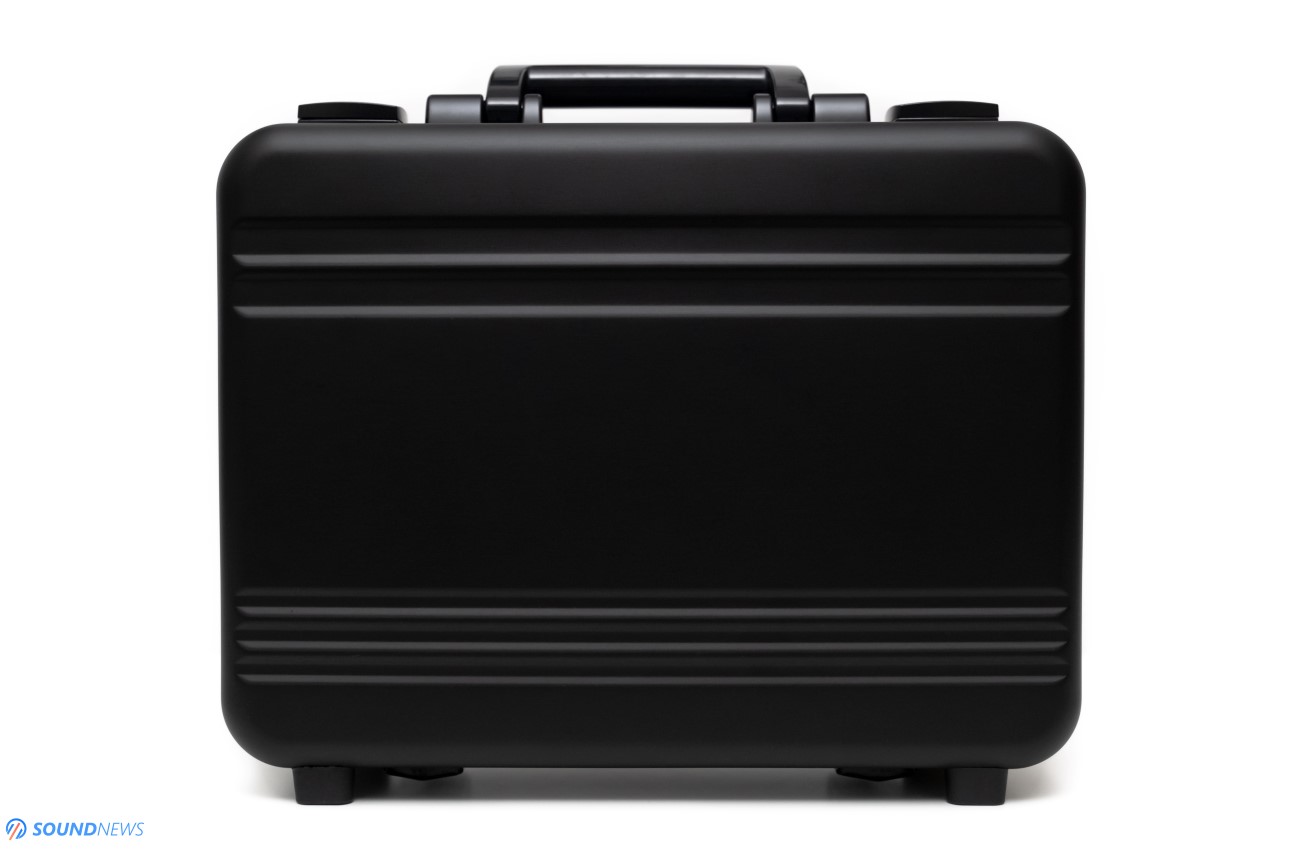
Unboxing Experience
When you see a metallic suitcase and a pair of white gloves after opening it up, you know that you’re dealing with something special. The LCD-5 is no longer coming in a plastic Pelican case, getting a much nicer metallic case that oozes a high-end flair. It has the right size and it features a locking hinge, you can lock it with the included keys, just in case you’ll be traveling in a Man in Black suit. The case itself is nicely protecting the LCD-5 from the outside world thanks to plushy foam inserts. Besides the headphones themselves, you are getting two keys, a pair of while gloves, a certificate of authenticity, a warranty card and a high-end detachable headphone cable terminated with either a 6.35mm or with a 4-pin XLR jack, depending on your order. This is not your regular stock cable, but a much nicer and thicker one (AWG 20) that uses high-purity, cryogenically treated Ohno-Continuous-Cast (OCC) copper conductors. This is as high-end as it can get and you can purchase it separately for $599 for the rest of your headphone collection if you will.
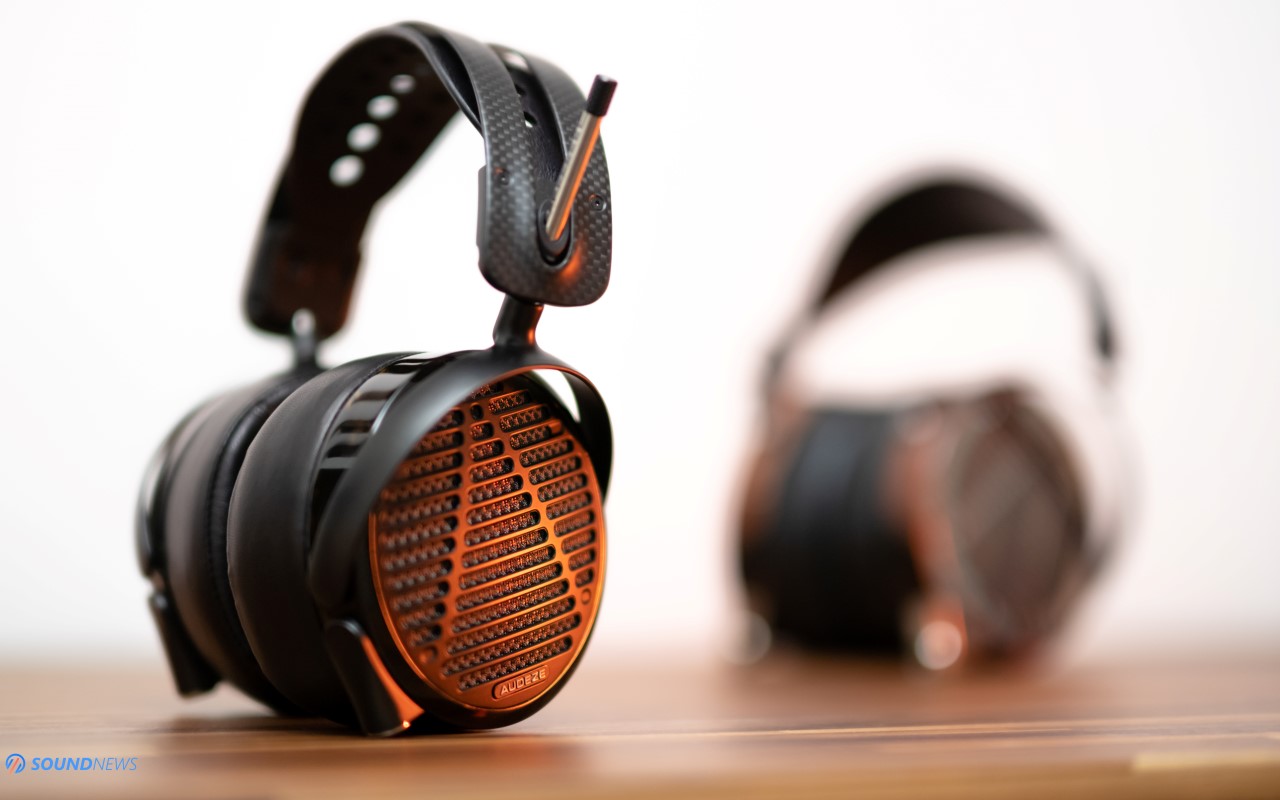
Build Quality & Looks
After introducing the LCD-5 and seeing a very different headphone part of the LCD series, I didn’t know how to react. On one hand I was super excited, as finally my beloved LCD-4 would be getting a successor, on the other hand…I felt sad, as everything I knew about the LCD series was completely reshaped and re-imagined from the ground up. Massive, beautiful wooden cups were replaced with smaller and lighter ones made from acetate. Acetate is a hard bio-plastic that is used as a film base in photography, as a component in some coatings and as a frame material for eyeglasses. This is one of the earliest synthetic fibers, based on cotton or tree pulp cellulose. On the plus side, acetate doesn’t have an odor, it is easy to fabricate and feels sturdy, on the flip side…it doesn’t look as unique as wood does. Moving forward, it seems that every aspect of their acoustic chamber was optimized for minimal reflections, that lowered distortion and improved stereo imaging. Their grilles are protected by an acoustically transparent mesh that was designed to minimize resonance. On the other side of the cups, you can spot newly designed low-profile Fazor waveguides that will further reduce diffraction and interaction with the human ear.
Their ear-pads were shrunk retrofitting smaller ear-cups, but these are still made from soft and high-quality leather. These are sculpted in shape of a cone, that improved directivity of the waveguides, sending sound waves with minimal reflections towards our eardrums. Their ergonomic design cradles your cranium and helps naturally place the headphone in an optimal listening position. Their pads have less contact area compared to standard pad designs, reducing fatigue while providing a superior seal for all shapes and sizes. I’m already smelling a much lower distortion, but will see about that in our measurement analysis.
Their structure feels as solid as it was before, but it’s much lighter now that improved comfort long term. Although we are still getting a carbon-fiber headband, it’s cooler looking and you can even adjust the stiffness of the rods, which is a cool addition to the LCD-5 features list. The absolute biggest improvement is the weight that went from 690 grams all the way down to 420 grams, losing a 1/3 of its weight, offering a lower pressure on top and around the ears. Long story short, it seems that every single part was re-engineered using longer-lasting materials as magnesium, aluminum and acetate, offering a lighter weight and a higher rigidity than ever before.
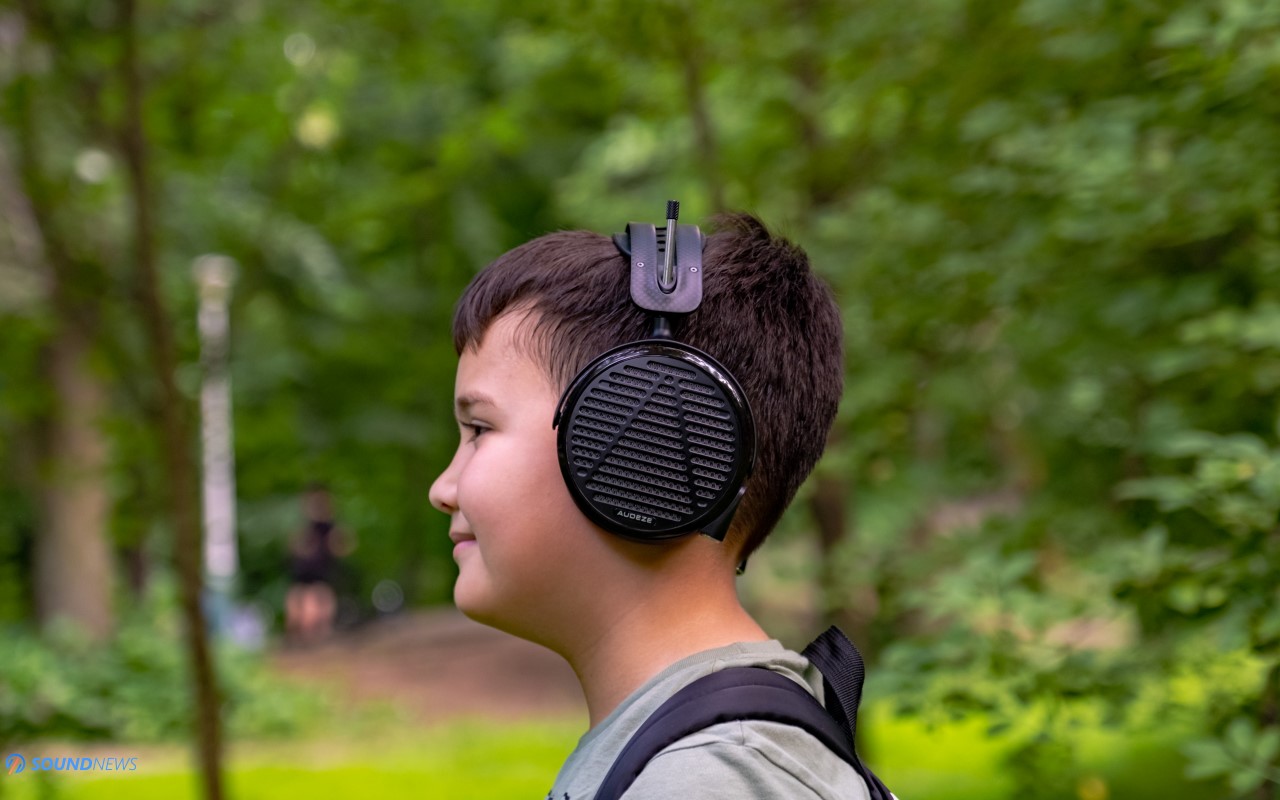
Comfort Level
LCD-5 are the lightest headphones in the LCD line-up and that can be felt immediately after playing with them for a few minutes. It takes time in finding the perfect spot, but once these are clicking into place, you can almost forget that an Audeze headphone sits of your head. The clamping force is a little higher to what I was expecting, hence using a wider rod position, but I can still use then for longer periods compared to the LCD-4. While I don’t find them perfect for my head size, these are still easier to wear in long listening sessions.
While LCD-5 aren’t using the biggest or the deepest ear-pads out there, these are still soft enough and I find them quite gentle on my cheeks. There’s no air pressure building up due to an open-back design, so you should forget about sweaty ears in the summer time. They fit around my head snugly and provide enough padding, putting just a bit of pressure around my ears and I believe bigger heads might have some issues in finding a sweet spot. In my case, there was a higher side pressure in their stock form, but once I’ve adjusted their rods, everything went back to normal.
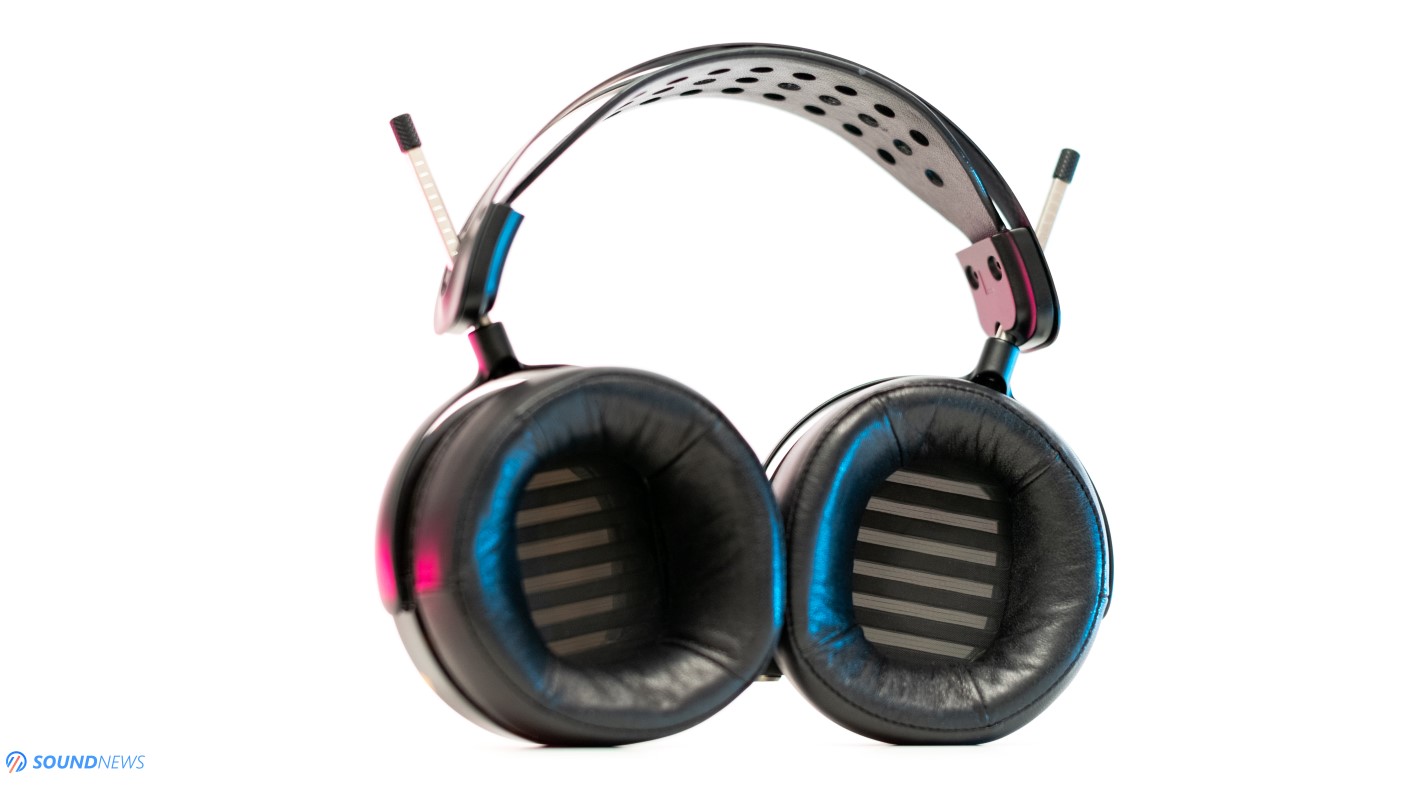
Technology Inside the LCD-5
The LCD-5 is a full-sized open-back planar-magnetic headphone that employs an in-house developed planar driver. Audeze went back to their drawing board and came up with a smaller 90mm driver versus a 106mm one found on all their past flagship cans. Audeze describes the inner workings behind LCD-5 with the following words: “Its drivers are engineered with our award-winning Fluxor magnets and updated Fazor waveguides along with our new Patent-pending Parallel Uniforce voice coils, which employ varying width parallel traces to keep the impedance low and provide increased voltage headroom by altering the current density withing each trace. The uniform trace created by this optimization lowers distortion and provides better control over diaphragm movements, resulting in improved sonic resolution.”
Instead of a push-pull double-magnet configuration found on the LCD-4, Audeze went with a single-sided magnet array, using strong N50 Neodymium magnets, which contributed to a massive weight loss versus the iron-maiden LCD-4. The spacing between magnets was increased deliberately, there’s a brand-new voice coil and everything combined is now called Fluxor Magnet Array.
You’ll find a detachable cable in the package, that uses cryogenically treated high-purity monocrystalline copper conductors, making it the best cable that Audeze has ever made. Disregarding its Rean mini-XLR connectors, I like everything else about this cable. It lacks microphonics, it’s pretty long, it feels sturdy and well put together and most importantly – it sounds great.
The final result? A much lower impedance of 14 Ohms versus 200 Ohms on the LCD-4 tremendously improved their sensitivity. Sending a 300 Hz sine-wave towards the LCD-4 at a SPL of 90 dB, translated into a 96 dB SPL on the LCD-5, making them the easiest to drive flagship headphones that I know of. Before moving forward, you should know that I have these for more than six months, as I needed to test them with as many headphone amplifiers, so I can better understand them and unleash their fullest potential. What are we waiting for? Let’s hit some eardrums!
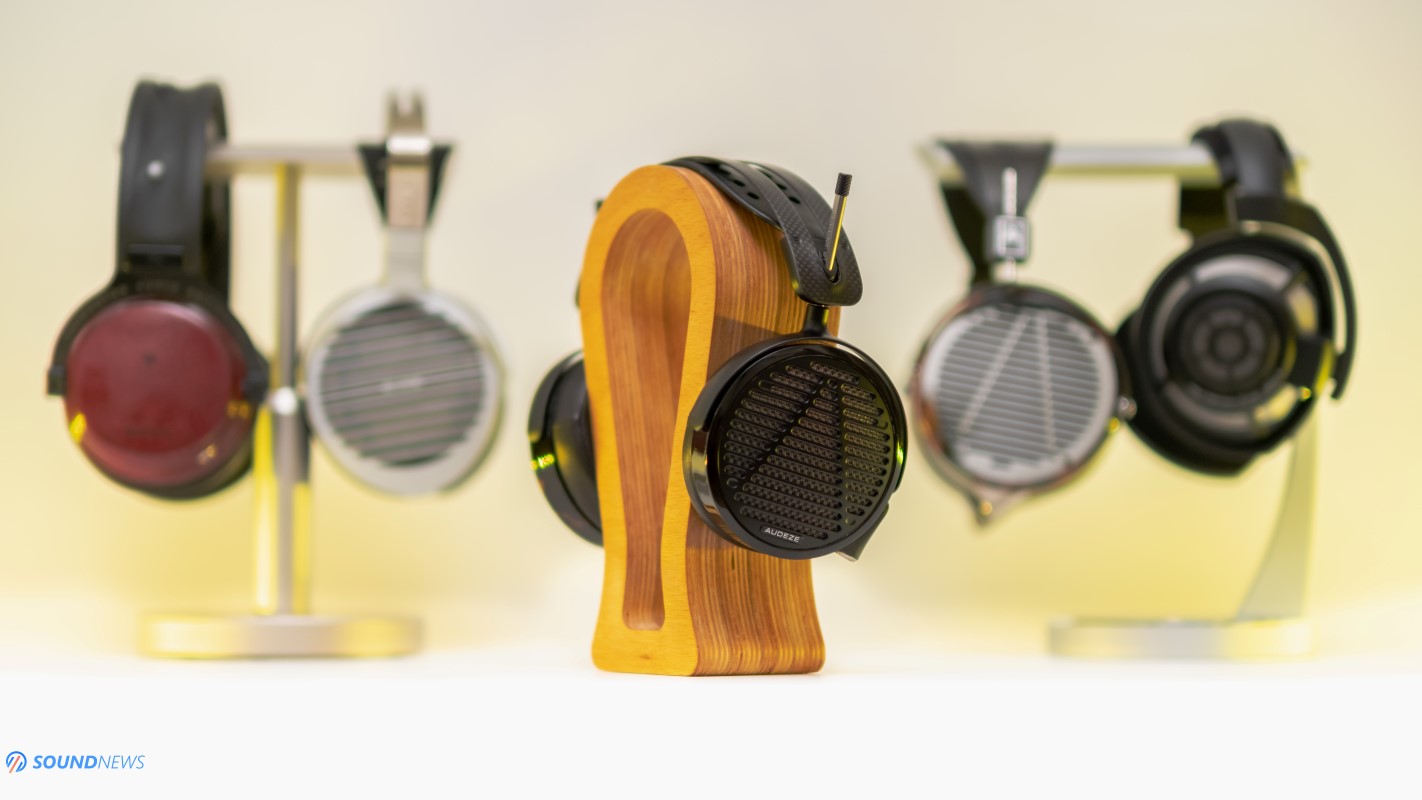
Sound Performance
I. Preliminary Impressions
After trying every single headphone from the LCD line-up in the comfort of my home, once I’ve put the LCD-5 on…there was a long moment of silence, as I wasn’t prepared for such a different sound signature. I was little disappointed, as it felt like listening to an Audeze planar from a parallel universe. Everything I knew about the Audeze house sound, was no longer dwelling inside the LCD-5. If you check some of the latest high-end headphone developments, you’ll observe that most brands started putting a higher accent on detail retrieval, on fast transients and lightning-fast dynamics. Meze crafted their Elite as a much faster, clearer and linear sounding headphone, Abyss made their AB-1266 Phi TC more resolving, Hifiman pushed to the limits their Susvara and it feels like the right time for Audeze to respond to their competitors with the LCD-5.
A shocking amount of micro-details moved forward, more information was being revealed all over my tunes and the change of pace was mind-blowing…to say the least. The speed and decay of the notes felt much quicker, everything felt snappier and tighter sounding than ever before. Stereo imaging felt precise and spot on, I could better sense musician’s location and feel the shape of their instruments much clearer. In spite of that, there were a few things that didn’t resonate with me that well. The soundstage took a small hit, as from an out of head experience via LCD-4 that stretched past my shoulder level, LCD-5 felt closer and more intimate sounding by comparison. While imaging was sharper and a whole lot more precise, the notes were playing closer to my head, invading some of my personal space. Depth and imaging felt amazing after a few days of non-stop playback, but it seems that the soundstage didn’t improve that much. Another change was getting a lower sub-bass extension and punch, trading with a tighter and higher quality bass. Sadly, LCD-5 isn’t looking as bass heavy, highly impactful headphone as LCD-4 was doing it for me, getting a reference bass quality instead, in line with the rest of the flagship headphones.
As more tunes were hoping on board, it was clear to me that Audeze envisioned the LCD-5 as a different sounding headphone. Physically, it doesn’t look like anything they’ve done before and the same can be said about their sound signature. When LCD-4 hit the market a while ago, it was marginally better to their predecessor when it came to measurements and technical performance, but with the LCD-5 they made a giant leap forward, crafting an esoteric unit in all regards. While its predecessor couldn’t be used in the studio, due to a limited upper midrange, lower and mid-treble delivery and to a lower-sensitivity that demanded a serious amount of power. That is no longer the case with the newest LCD-5, which felt complete in terms of frequency response and much cleaner sounding in all regards, hence marketing it for the audiophile and Pro Audio market alike. While LCD-4 worked great with upper-class headphone amplifiers, many studio consoles couldn’t drive them and it seems that LCD-5 is no longer such a heavy burden. The power intake is considerably lower compared to that of the LCD-4, as even portable dongles and digital audio players have no problem driving the LCD-5, unlocking mood-lifting dynamics on the go.
If you consider yourself a hardcore Audeze fan, then please don’t take seriously your first impressions of the LCD-5, as it takes time in appreciating and unleashing their full potential. After having them for more than six months now, they slowly and gradually started growing on me and after trying about fifteen desktop headphone amplifiers, it seems that powerful tube amplifiers will improve their layering, scale and the final kick. You can build a system around them pretty easily without breaking the bank and I would personally stay away from op-amp based amplifiers and use only transistor or transformer-coupled tube amplifiers for the best results.
Long story short, everything that was creamy, overly smooth and full-bodied, transformed into a more linear and honest sounding headphone that straightened the frequency response, tightened decay of the notes and pressed the gas pedal to the floor in terms of transients. If LCD-X felt like a rebellious child from the LCD line-up…wait until you hear the LCD-5 and everything it has to offer.
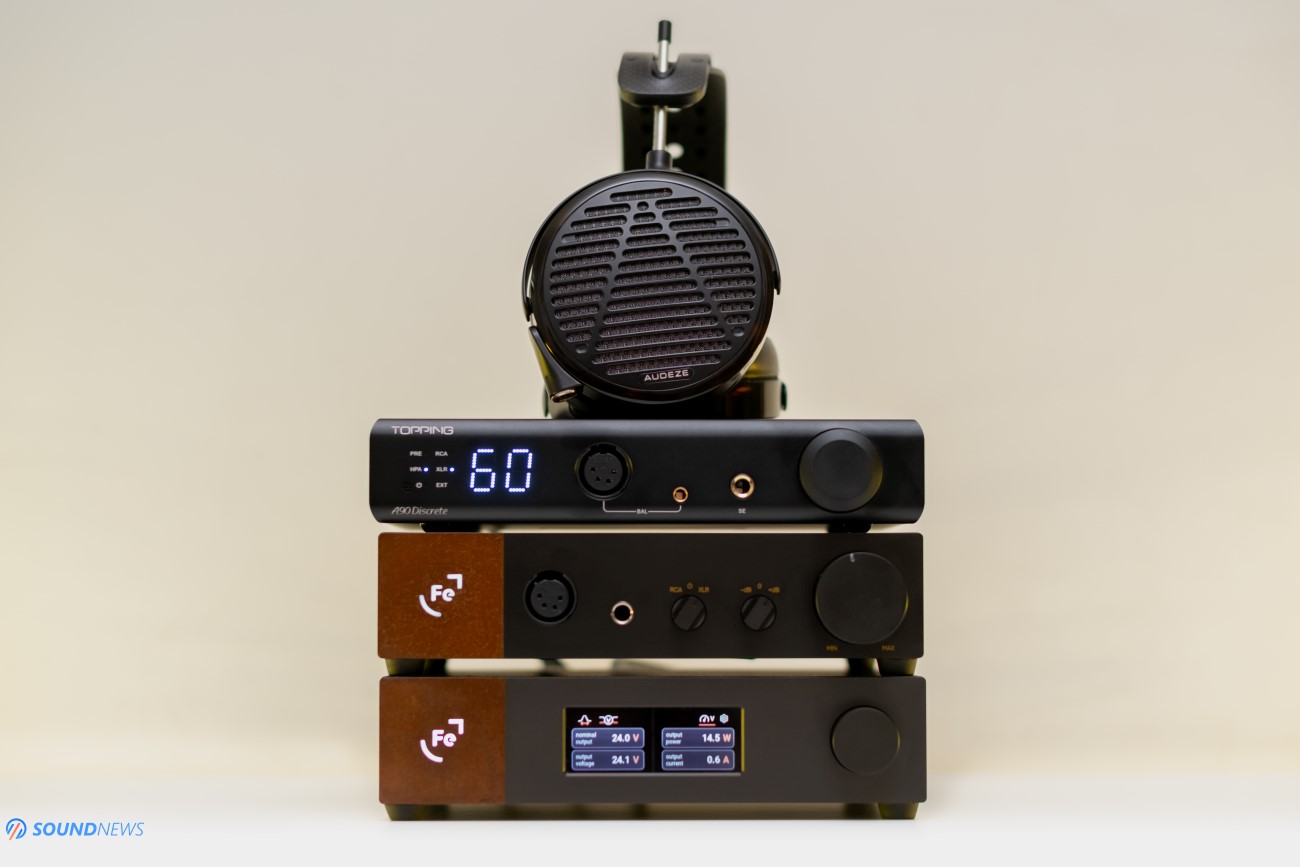
II. Power Requirements & Amp Pairings
Sending a 300Hz sine-wave towards the LCD-5 at an SPL of 90 dB, translated into an 84.2 dB signal on the LCD-4 and a 90 dB sine-wave on the LCD-4, translated into a 96 dB one of the LCD-5. Generally speaking, an increase of 10 dB roughly corresponds as being twice as loud and for that reason you should be careful when switching from LCD-4 to LCD-5, as the sound gets much louder. I personally dislike low-sensitivity headphones as some of them were demanding so much power, that integrated or power amplifiers were required the best results (see my Hifiman Susvara review). Audeze’s LCD-4 weren’t a walk in the park for most headphone amplifiers, as they needed considerably more juice to anything they’ve done before.
When LCD-5 landed on my table, I found them easy to drive, so much so that I started carrying them in my long trips together with a portable digital audio player that could stream music wirelessly, as FiiO M17 or Shanling M7. Lowering impedance from 200 Ohms on LCD-4 to just 14 Ohms on LCD-5 and blessing them with a lighter magnet array made a substantial difference to their sensitivity. As simple as it sounds, LCD-5 are much easier to drive, so much so that even a few USB type-C dongles of mine worked with them no problem. This is a very positive change, as LCD-5 are no longer glued to desktop electronics. If Audeze would use the same tech in some of their affordable headphones, then I wouldn’t be surprised seeing geeks in coffee shops working with Audeze headphones on their heads. LCD-5 is no longer binding me to desktop electronics as LCD-4 did and I can only congratulate them for that.
It doesn’t mean that regular headphone jacks of your smartphones, tablets and laptops would be doing them justice, as that wouldn’t be the case. If you have cash to burn for a headphone like this, then you definitely prepared a budget for a dedicated audio source and amplifier, as LCD-5 shines much brighter with dedicated electronics. On the go, small but powerful gizmos as FiiO BTR7 and Shanling UA5 were more than capable in driving them, with a small drop in dynamics and bass impact. Moving up the ladder to mid-level portable DAPs like Shanling’s newest M6 Ultra and FiiO’s newly released M11S, things started improving, as I’ve got a much higher headroom, there was a bigger scale of the music and a more impactful presentation. Out of them, M6 Ultra’s warmer midrange and powerful bass worked better with the LCD-5, versus a neutrally tuned M11S of FiiO. Higher-end DAPs like Shanling M7 and FiiO M17 were already blurring the lines between portable and desktop devices, as both sounded more like a well-made desktop DAC/Amp combo, adding even more power on tap while unlocking excellent dynamics.
LCD-5 sounded the best and almost unrecognizable out of a Trafomatic Primavera, followed by an Enleum AMP-23R. Primavera expanded their soundstage and put back the missing sub-bass energy, getting them closer to LCD-4’s enjoyment level. On the cheap, LCD-5 sounded excellent out of a Topping A90 Discrete and Singxer SA-1, that made them by a hair snappier sounding versus entry-level desktop amplifiers.
In the end, Audeze made them easier to drive and easier to enjoy, as you no longer need gobs of power to awake nicer dynamics and I will no longer put them up there with the Audeze LCD-4 as some of the hardest to drive planars. This seems like a positive chance of pace and I’m wondering if newest Audeze cans would get the same treatment.
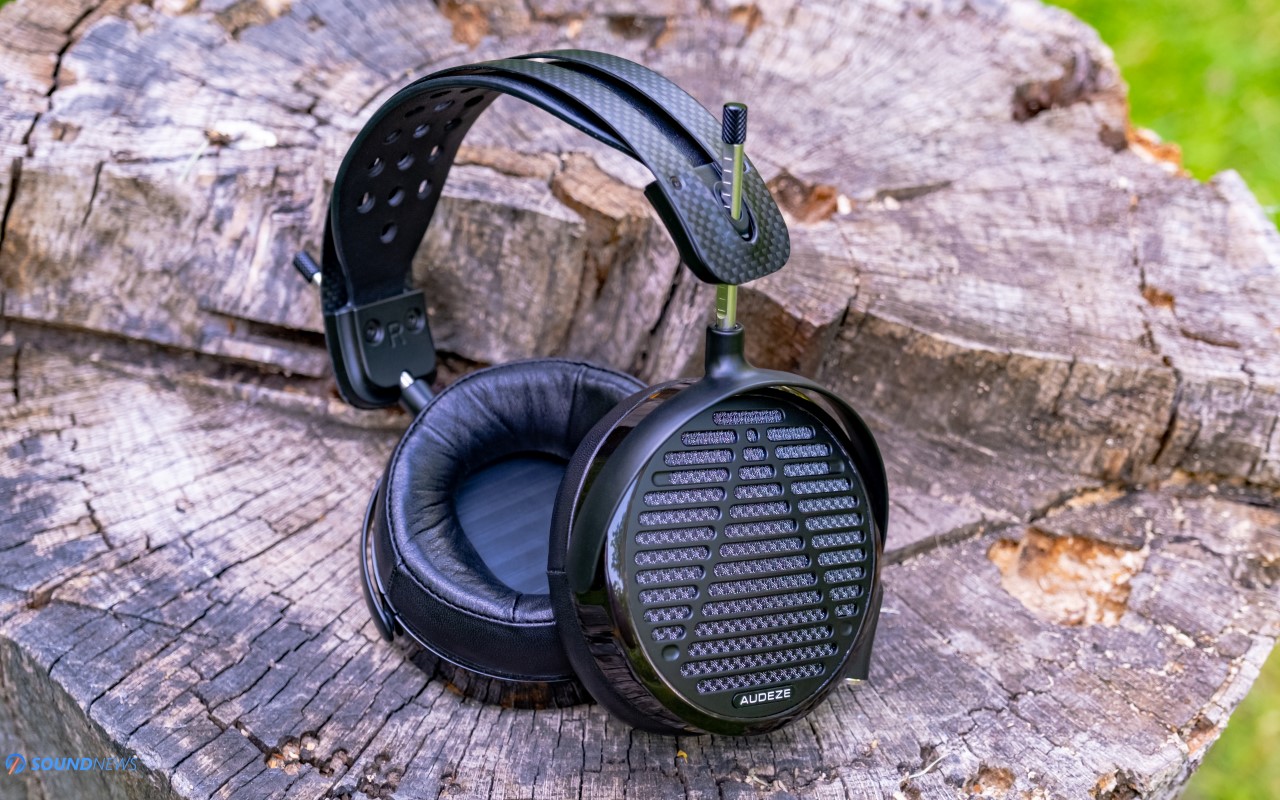
III. Transient Response
LCD-5 are fast sounding, way faster than any other Audeze headphone to date, it almost feels like listening to an electrostatic can put on a Class-A push-pull amplifier. With the right setup, LCD-5 can reach an e-stat like speed and decay. Up to this point, LCD-X were their fastest headphones to date, but LCD-5 took their place, getting shorter decays and an instant start and stop of the drivers. The biggest shortcomings of the LCD-4 were speed and resolution and it seems that LCD-5 solved them both, getting a much tighter sound throughout the entire frequency response.
While LCD-5 are quite sensitive and can be driven by portable devices, they still have big planar magnetic drivers, massive Fluxor magnets and updated Fazor elements and for a tighter control of their drivers, a higher current need to be delivered to their drivers on the spot. They sounded great out of several high-end DAPs like Shanling M7 and FiiO M17 and a little better out of a proper desktop setup. A welcome surprise was the newest Topping A90 Discrete that didn’t limit their performance, sounding effortless, unrestrained and quite engaging out of it. Putting them on higher-class amplifiers awoke nicer dynamics, more oomph and rumble could be felt in the bass, an added nuance and substance in the midrange, making them easier to listen to with less than perfect recordings.
With all that said, there’s one thing that wasn’t as impressive as it was on the LCD-4 and that’s the bass slam. While LCD-5 aren’t limiting the final kick in the mid-bass, there’s definitely a gentler delivery in the sub-bass region. LCD-5 will easily reach the lowest octaves as 20 Hz (as my measurements will prove shortly) sustaining them without adding distortion, these didn’t feel as impactful to a point of becoming painful as it might happen with the LCD-4. The bass rumble felt gentler, there is less oomph and it goes without saying that LCD-5 isn’t a bass-heavy headphone, but you can improve their low-end delivery with a mild EQ or with a punchier sounding amplifier. Quantity wise, LCD-5 are losing some ground to the LCD-4, but are winning massively when it comes to bass quality, getting it faster and considerably tighter in busy passages. Overall, I’m getting a 10 out of 10 speed and decay and a solid 8.5 out of 10 in terms of bass slam and impact.
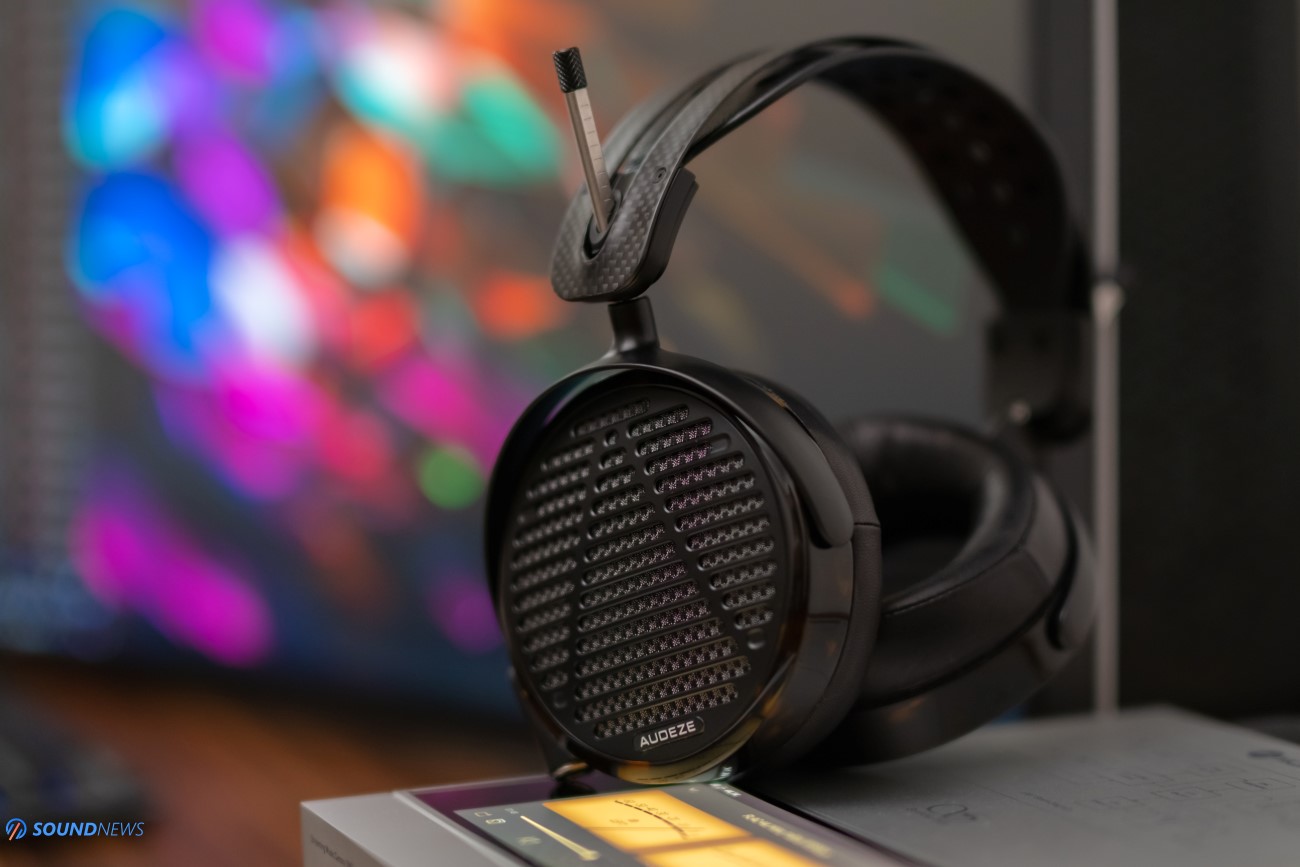
IV. Soundstage & Depth
Before telling you about their scale, depth and layering, let’s zoom out just a little bit as I want to share my loudspeaker adventures. I started with small active near-field speakers and later build a passive stereo setup in the living room. I was swapping them quite often, at least two times per year and I observed that three things stood out immediately to me.
First of all, bigger woofers moved higher air quantities, directly improving the scale of the music. Bigger woofers were widening the stage in all directions, as I had more music to my left and right. When I tried bigger cabinet sizes, especially after trying a bunch of standfloor passive speakers, I observed that a better dampening behind the drivers and a longer bass port, improved the layering, the low-end delivery, making everything so effortless and believable. I was skeptical that bigger cabinets could make such a tremendous impact on the layering and effortlessness, but it was so obvious that I couldn’t go back to regular stand-mount speakers. Lastly, when I’ve tried deeper cabinets, weirdly enough…the sound became deeper as well and I finally understood what people meant by getting a sound that was bigger than their room size, with music coming from within the walls. After combining all three, you’ll surely get a massive scale, depth and layering that becomes so real and effortless.
I wanted to derail this chapter, just to express how important is everything when building a loudspeaker or headphone. I strongly believe that the same principles are applied to headphones, as the biggest sounding ones still have the biggest drivers and the deepest ear-pads. LCD-4 is easily part of that group, as I can never get enough of that deep reaching sound. This is probably the only part that didn’t impress me as much, as Audeze put smaller drivers and ear-cups, slightly narrower ear-pads that led to a smaller scale of the music. What stretched open and wide in all directions, felt closer and more intimate, what was vast and huge transformed into a medium-sized stage and what was deep reaching, felt on-stage with the musicians.
Don’t get me wrong, this is still a flagship open-back headphone that sounds like one, but it won’t stretch its wings and fly off as it usually happens with the LCD-4 and Sennheiser HD800S. Take everything I’ve said with a pinch of salt, as soundstage via headphones is still an exaggerated concept, as no matter what you do, headphones drivers will be sitting in a close vicinity to our eardrums. There’s a much bigger difference in between open-back and closed-back headphones, than in between the LCD-5 and LCD-4, so not everything is lost. However, there is a cure for the limited soundstage and those are transformer-coupled tube amplifiers of all sorts, not hybrid…but pure-blooded tube amps that would add bigger void spaces in between the notes, would decompress the music by a little and add more air everywhere around, for a deeper, taller and wider presentation.
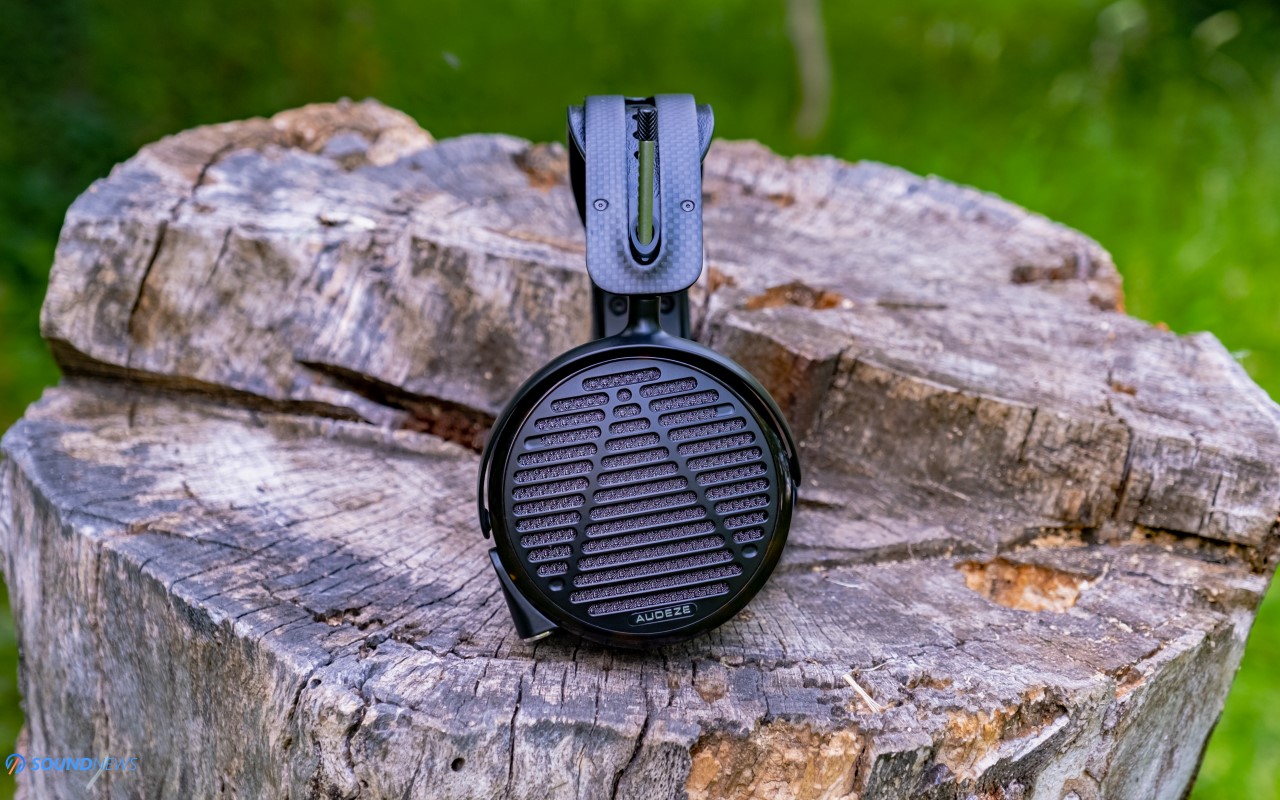
V. Detail Retrieval & Transparency
Now take everything I’ve said in the previous chapter, turn it upside down, multiply it by ten and you’ll get what’s so special about the LCD-5 in the first place. There’s one thing that LCD-5 are doing extremely well and that’s revealing as much information as possible, without tiring the listener with an exaggerated sharpness or treble ringing. If you previously checked my Hifiman HE1000SE review, I called them extremely resolving and transparent, coming dangerously close to the Hifiman Susvara and Sennheiser HE-1 levels of transparency and detail. By comparison, I find the LCD-5 equally impressive, but slightly better long term as there’s no listening fatigue that’s (sometimes) associated with the HE1000SE put by wrong amplifiers. That slightly itch and ringing happening in the upper treble is no more, although I still hear feel the shimmer and vibration of the cymbals. Although Audeze radically changed everything we know about the LCD series, starting with design and finishing with sound quality, there is one thing that remained and that’s an effortless and true to life presentation, that makes listening to music a breeze even with bright recordings. LCD-5 aren’t only extremely detailed with all of my tunes, but easy to enjoy thanks to their natural and organic presentation. In this regard, LCD-5 is very different to say an Abyss AB-1266 or Hifiman HE1000SE, that are putting a higher accent on the sharpness of the notes.
After trying out every single headphone from the LCD series, I believe the jump in transparency and clarity from LCD-4 to LCD-5 is bigger than going from LCD-2 all the way to LCD-4. It hits you directly and it hits you hard with a denser wall of information, constantly bombarding your eardrums with tiny intricacies and petite nuances that weren’t present on previous Audeze headphones. While I can listen to music via LCD-5 while replying to some of your messages all around, I can’t do that with a pair of Hifiman Susvara or Abyss AB1266, as LCD-5 isn’t stealing my attention with defined leading edges and overly sharp contour of the notes. I understand both styles and I can appreciate them individually, but some of you might prefer a sharper style of previously mentioned headphones or a more relaxed and organic style of the Audeze.
On my newest head-fi rig, which I consider a reference one, LCD-5 were putting everything on a plate, unearthing huge amounts of details, sometimes too many of them as mastering errors started appearing even in well-mixed recordings. Between you and me, I won’t pair the LCD-5 with an overly neutral DAC and headphone amplifier, as I believe they need a small bump in the low-end and a small push in terms of soundstage. On the cheap, nothing can outperform a Topping A30 PRO, followed by a Singxer SA-1 and later by a Topping A90 Discrete. On higher-performance setups, Class-A amplifiers would be my weapons of choice, starting with Ferrum’s OOR, Burson Soloist 3X GT and later finishing with Enleum’s AMP-23R. If you want to reshape the sound of the LCD-5 into a scarier creature, then nothing would do it better than a full-tube amplifier like Trafomatic Primavera or Head 2.
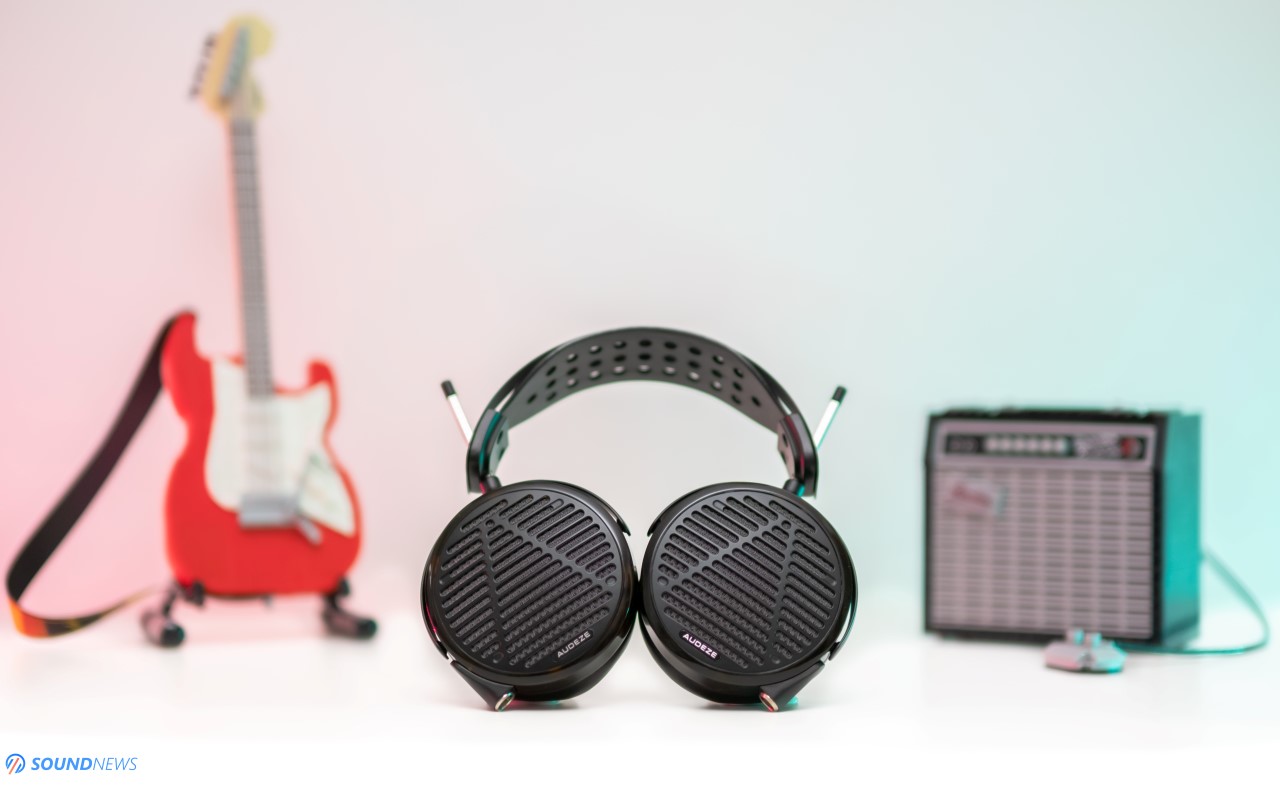
Frequency Response
VI. Bass
I’ll be blunt and brutally honest with you, LCD-5 can easily reach the lowest octaves, sustain them beautifully, without distorting at very high SPL (past 100 dB). LCD-5 can do sub-bass just fine, as later my measurements will prove, but it seems that a smaller cup design and a less-than-perfect seal is affecting the sub-bass delivery. I’m getting a decent amount of sub-bass if I’m casually putting them on my head wearing a pair of glasses and I’m getting a better definition and extension if I’m carefully rearranging them on my head while removing the glasses. LCD-5 drivers are capable of as much sub-bass definition, texture and impact, but something is holding them from reaching their full potential. Bass lovers will find the LCD-5 gentler, easier going and almost ethereal. These aren’t drawing attention towards the low-end, but mostly to their mid-bass region that felt fuller, richer and more playful. The legendary Audeze bass is still lingering inside and you can certainly awake it with nicer fully-discrete Class-A amplifiers or with a mild EQ curve. I think Audeze engineers wanted to steal our attention with a higher quality bass this time around, as every double-bass stroke and snare drum hit felt so defined and alive. LCD-5 offers a breathable type of bass and you can certainly feel that with funk, blues and all sorts of acoustic genres that have a higher mid-bass and midrange delivery. After getting to know them for a few months, they impressed more with acoustic music and less with fresh electronica tunes, where everything is about punchy 20 Hz notes. LCD-5 won’t deliver the full might of the Mjolnir hammer with dub-step, as their bass slam felt a little hushed, but that doesn’t mean these are bass-light, as still find them engaging and fun sounding.
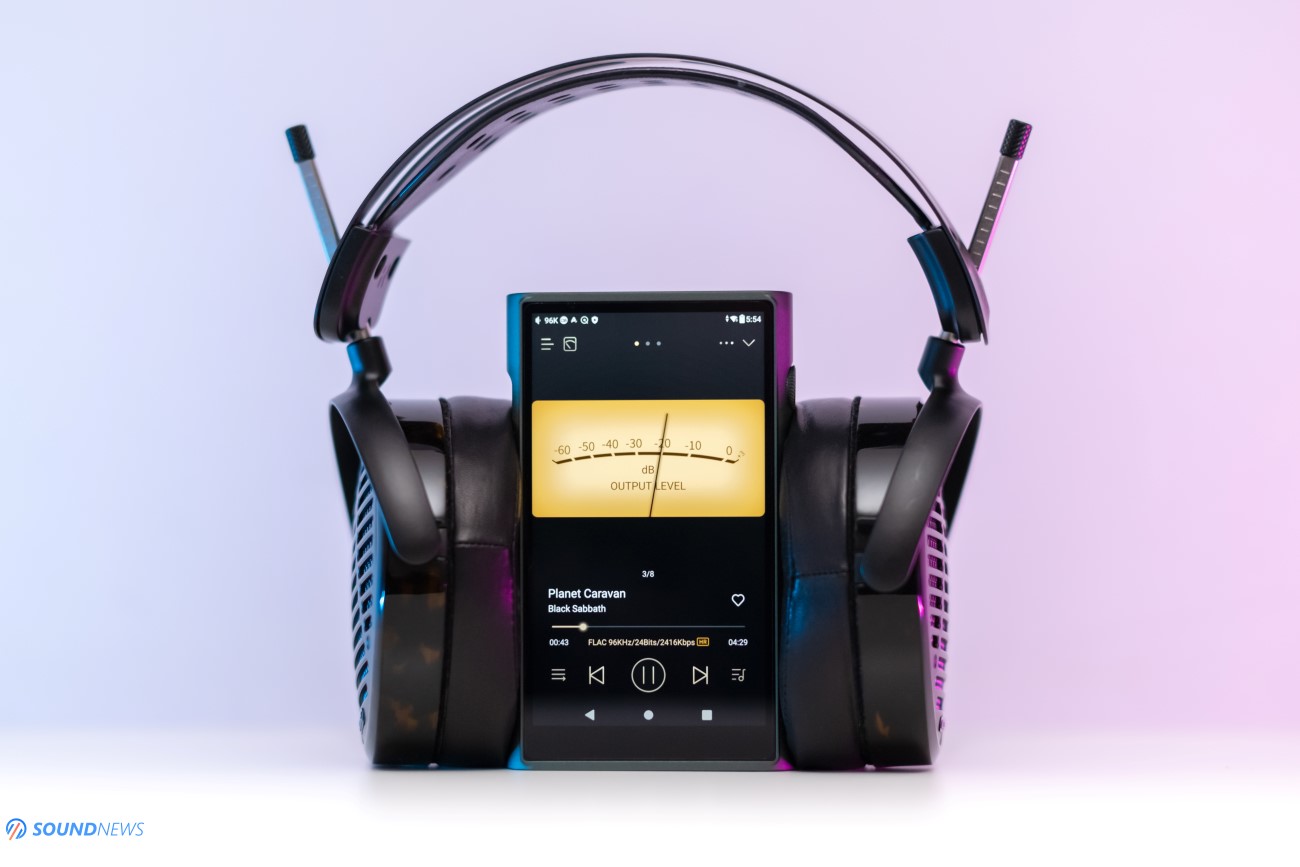
VII. Midrange
By far, the best thing about Audeze headphones, without an exception or exaggeration is the midrange department. While I don’t find it creamy and overly-sweet as it happens on the LCD-4, Audeze’s newest flagship is as full-bodied and natural sounding, without being slow paced or muddy sounding. If you never try the LCD-5, I would never call the LCD-4 as muddy sounding…but it feels that way when I’m comparing both. Since the newest flagship sounds more intimate, the same can be said about the midrange delivery which was pushed forward, becoming close and personal. I’m not bothered by a forward midrange, as this is still my favorite frequency region, but it can get a little claustrophobic, especially with cozy jazz tunes. Besides being extremely clear and oh so defined, LCD-5 are quite rich, warm and full-bodied in here, more so than any Hifiman or Abyss headphones. Depending on your setup and musical preference, this could be a major attraction, as most of the sounds are happening in this region. Everything that had to do with voices, keyboards and string-based instruments felt alive, organic and easy-going, but also technical and precise sounding. For no particular reason, when I’m thinking about LCD-5’s midrange, I’m thinking about a top sushi restaurant, that are cutting perfectly sized slices in front of the client, perfectly arranging them on a plate, getting just the right taste, aroma and freshness.
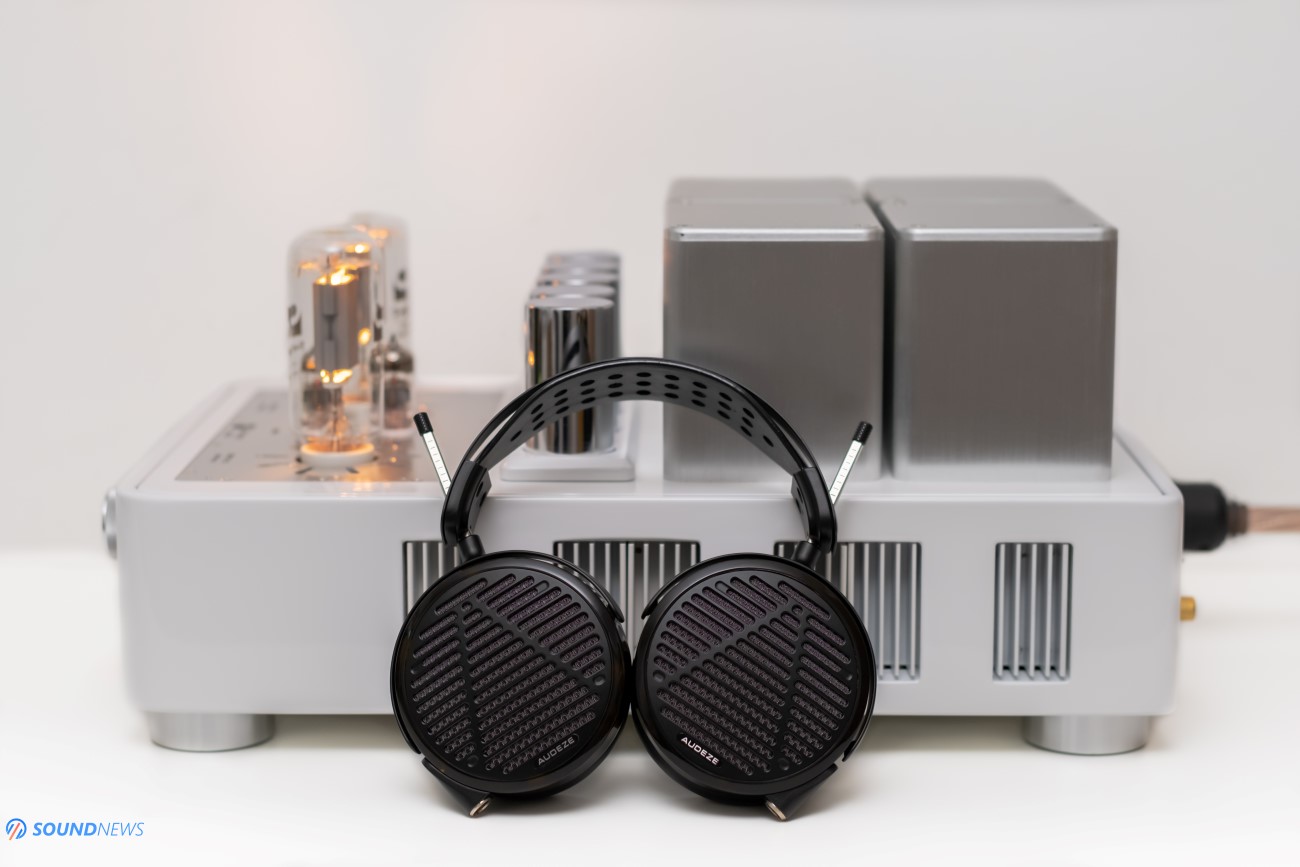
VIII. Treble
One of the biggest improvements versus all other Audeze headphones have been made in the treble region. While everybody knew that LCD-4 are rolling off parts of the treble, only after carefully listening to the LCD-5, you start realizing how limited the LCD-4 were in the treble. While LCD-4 starts dropping the treble by almost ~15 dB around the 3.5 kHz region, LCD-5 is not doing that at all. There’s more information with LCD-5, especially in the mid and upper-treble region, making them clearer and more defined sounding, without adding sharpness, treble ringing or any of that nasty digitus.
This is still an Audeze headphone for Odin’s sake, so you can completely discard notions as brightness or listening fatigue. LCD-5 are actually outperforming all other top-tier headphones in between 3 and 5 kHz, offering the most linear and true to life treble delivery. Audeze did a fantastic job in here, as I could listen even to mean rock and metal filled with treble energy to excess and I would cruise through those tracks without tiring me down. Bells and cymbal crashes were crisp and metallic, but without getting a fake treble ringing. Since these are ultra-fast sounding, double drums didn’t pose a problem even with the fastest and most demanding tracks. I like this kind of treble and thanks to its natural rendition, I can listen to anything without any awareness from my part. It goes without saying that Audeze put the spotlights in here, getting an extended treble delivery and I believe they achieved their goals with top grades. In the end, LCD-5 is no longer rolling off big chunks from the frequency response, as it feels more complete top to bottom, more linear and honest sounding down the road.

IX. Detailed Measurements
After offering my objective opinions, it is time putting them under a magnifying glass. I’m no longer using the Benchmark HPA4 as the main amp and Matrix Element X as the main DAC for the job, moving to a Singxer SU-6 that was galvanically isolating my PC, followed by a Chord Dave DAC and Ferrum OOR + Hypsos that were doing the heavy lifting. The measurement rig was a MiniDSP E.A.R.S. calibrated with HPN (Original Headphone Compensation) files. Please note that E.A.R.S. is not following any IEC standards, meaning that my readings can’t be used as reference measurements or anything like that, I’m doing them for a general idea about their sound signature.
I have measured them for several times now, as finding the perfect spot on the test jig wasn’t that easy. No side-pressure was applied to the ear-cups, they stood still in their natural position and I’ve measured them a few times before both channels felt matched.
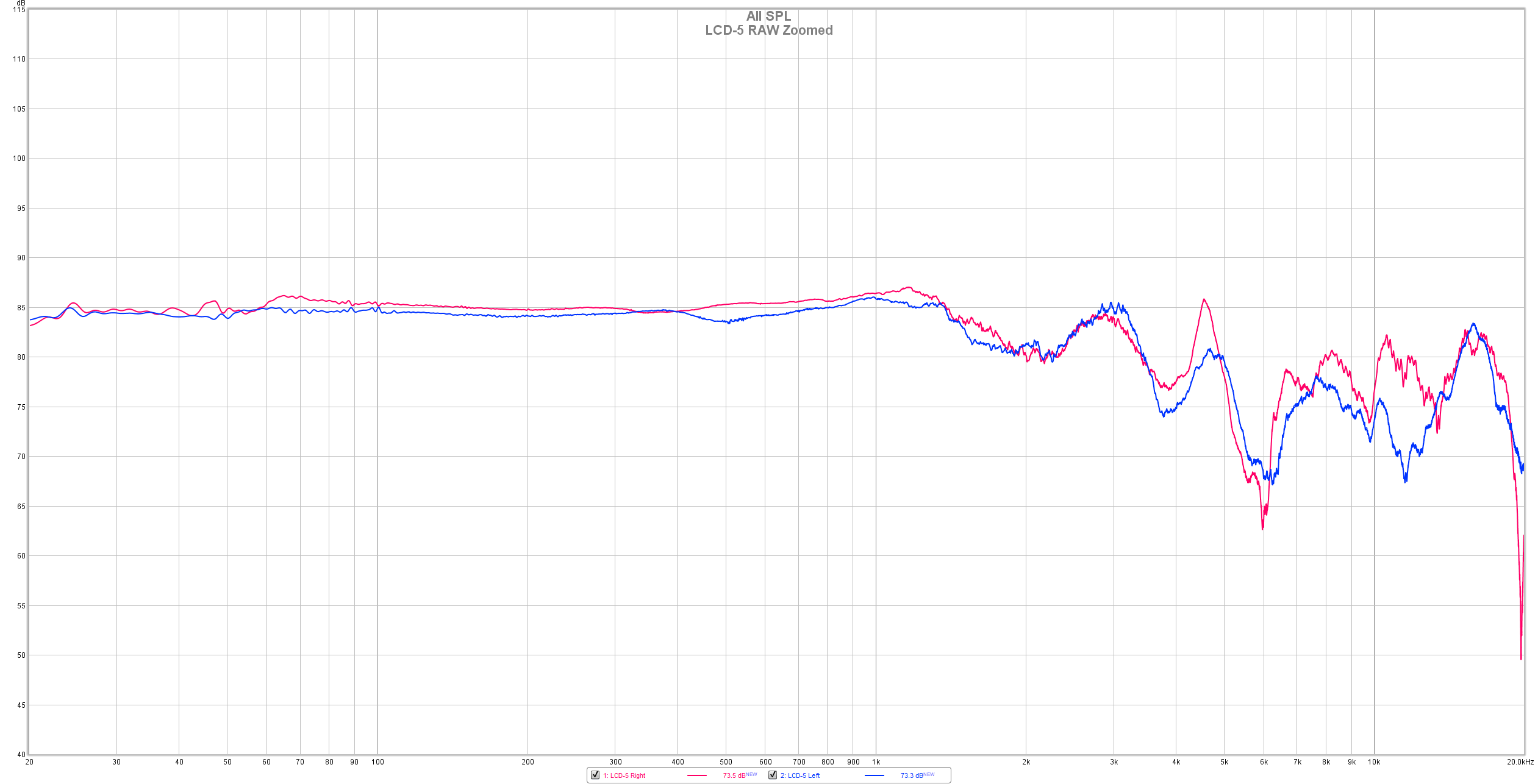
Take a look at their RAW measurements without any smoothing applied. Driver matching is okay, although I’ve seen better. There are some deviations in the treble, but those are minor. Do note that I’ve zoomed this reading quite a lot, so you could better see the deviations in between 11 and 12 kHz, but I couldn’t spot them while listening to music.
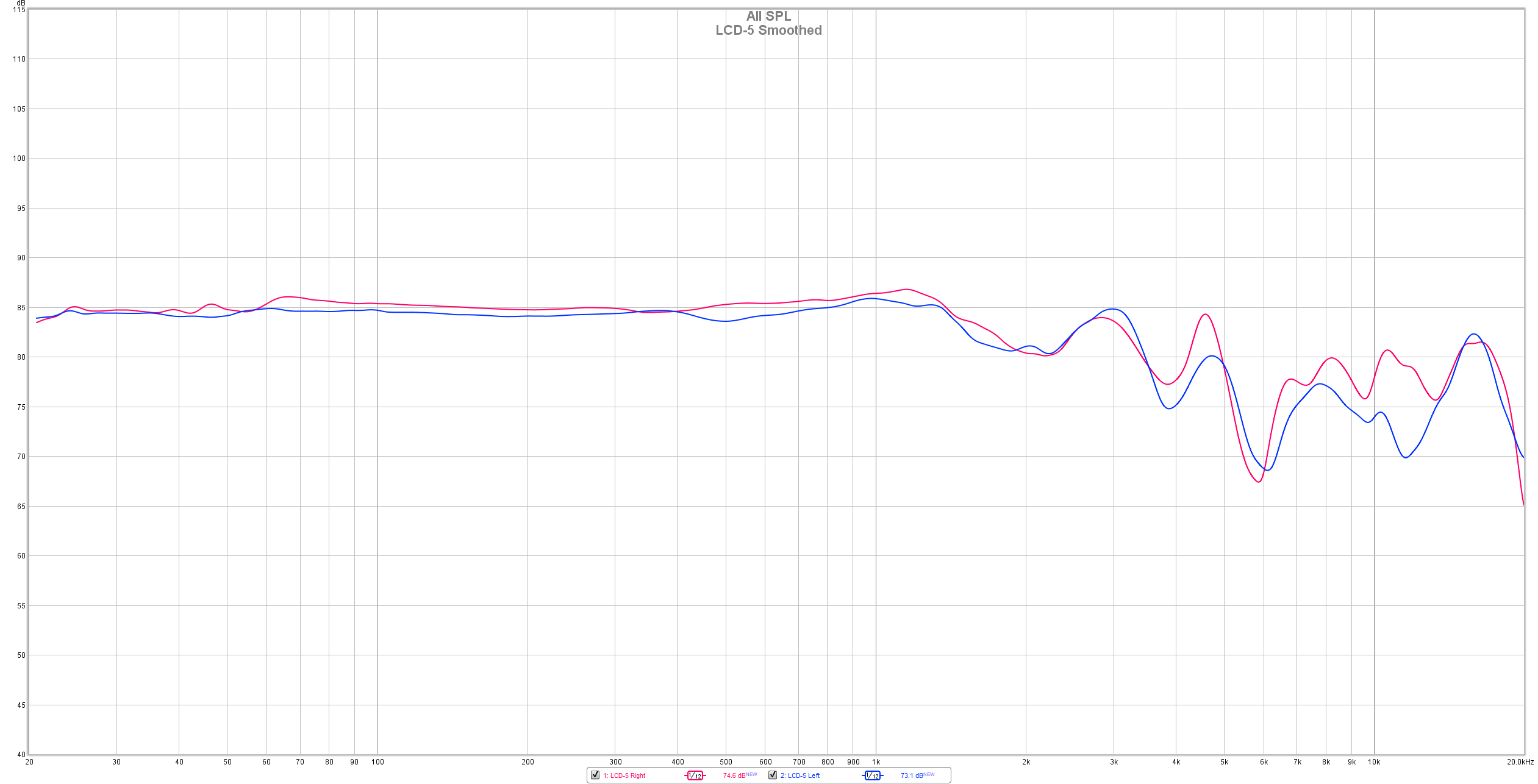
Applying a gentle 1/12 smoothing, I am getting a slightly different graph and you can see that Audeze LCD-5 offers a straight line from 20 Hz to around 1.5 kHz, suggesting that these are doing bass and midrange exceptionally well. There is a gentle slope in the upper midrange and another one in the top octave, but that’s normal behavior, as most flagship headphones are doing the same. Do note that the most sensitive part of our hearing isn’t affected as it was on the LCD-4, suggesting a much clearer and transparent sound. While I see a few slopes here and there, I can’t spot nasty rises that could badly affect dynamics and made them bright in long listening sessions.
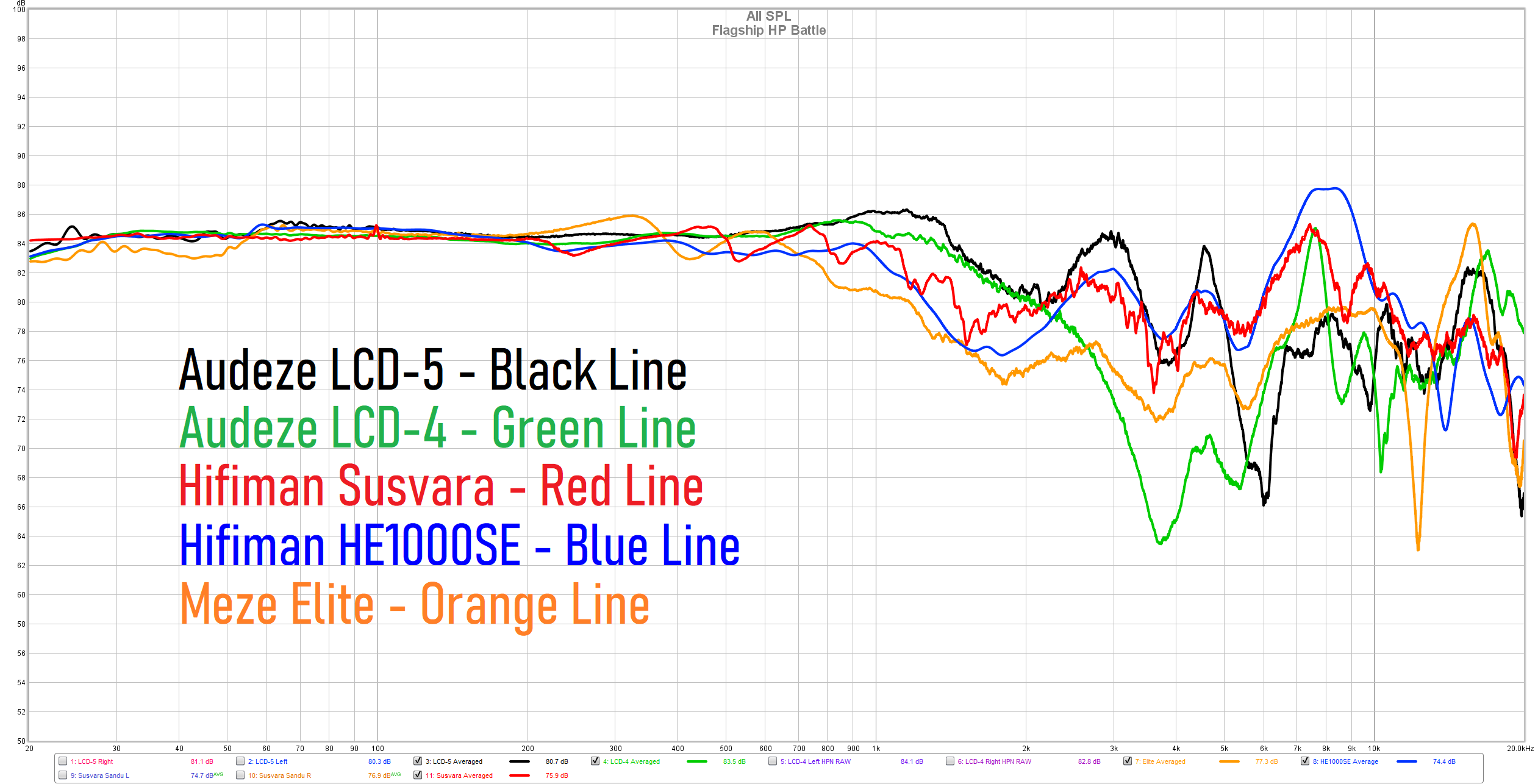
All in all, this is an amazing FR reading, that isn’t so different to the rest of the flagship headphone mafia and if you are curious how LCD-5 compares to them, here’s a graph that will tell you more.
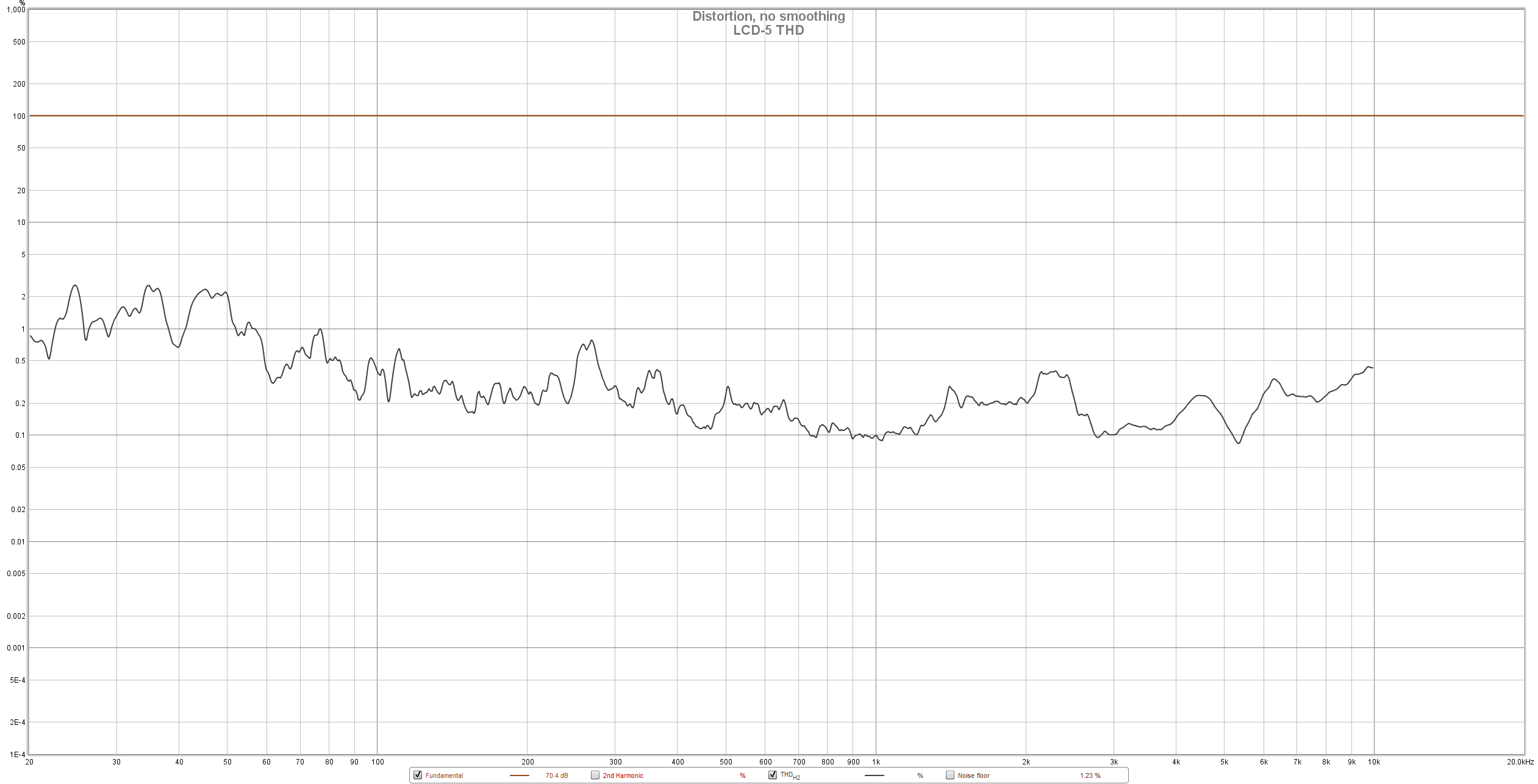
Their THD reading is great, it looks better than that of the LCD-4, it can reach as high as 2% in the bass and 0.4% in the treble, but it usually stays in between 0.1 and 0.5% – which is still great. A higher priced headphone delivered a higher THD, making the LCD-5 look like a flagship headphone by comparison.
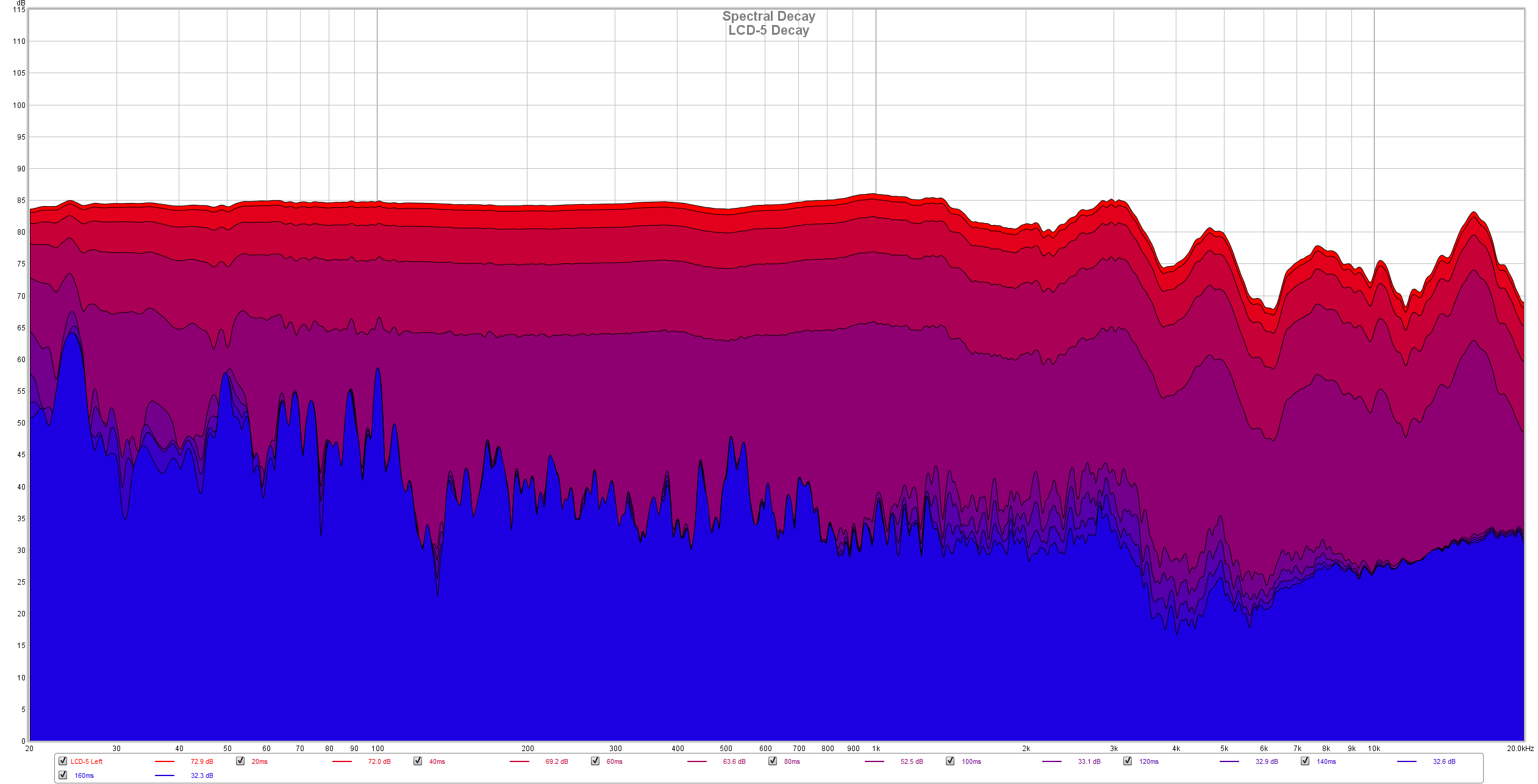
Spectral decay looks good, after sending a 300 Hz sweep tone at 84 dB and after a short time frame of 160ms, it drops to 20 dB at the lowest point and to 57 dB at the highest point in the FR, usually staying in the neighborhood of 30 dB. LCD-5 doesn’t only look like a super-fast headphone…this is actually the fastest sounding headphone that we measured so far, outperforming even the Hifiman Susvara and Abyss AB-1266 Phi.
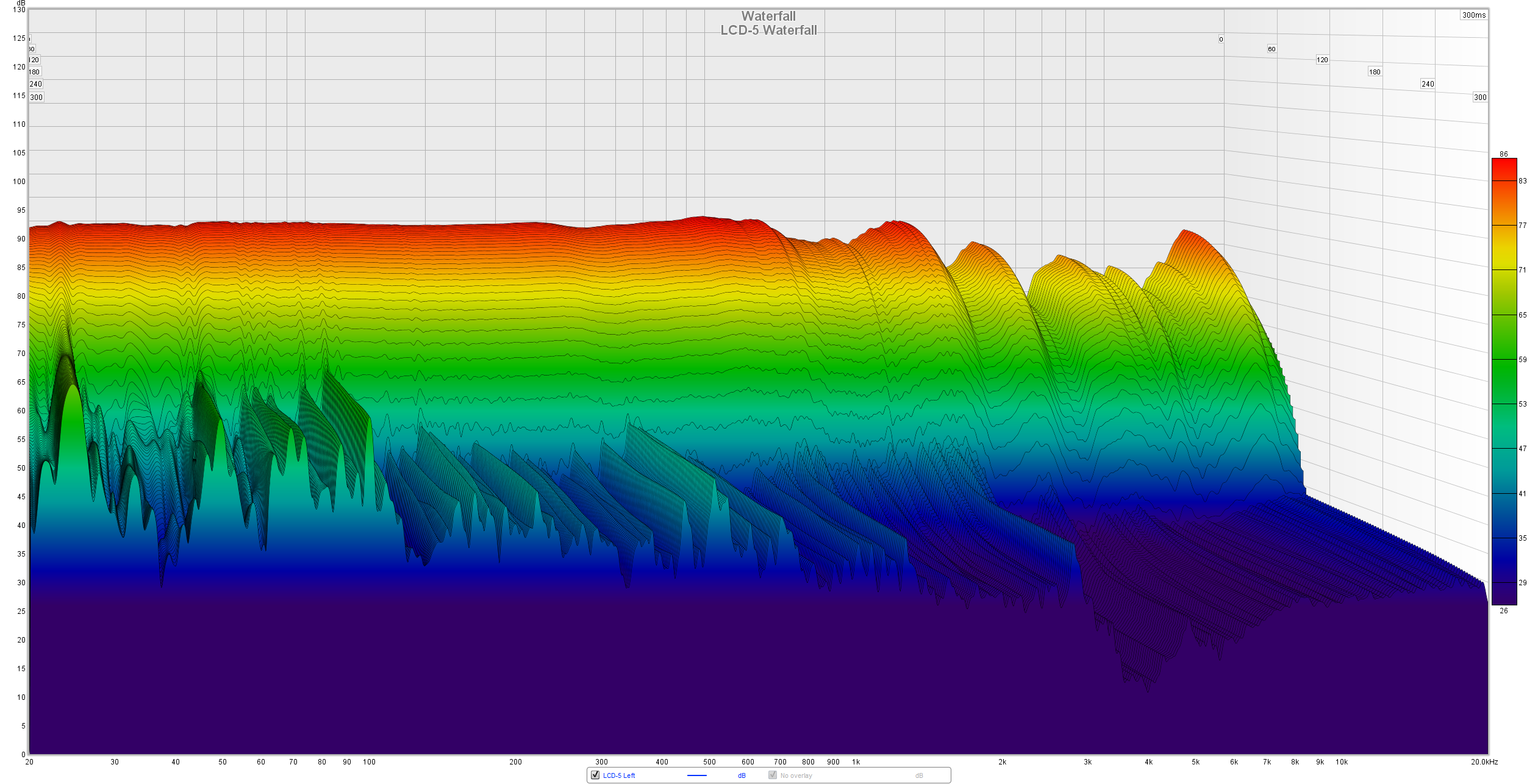
Waterfall combines the FR plot and decay into a single graph and you can clearly see their FR looks absolutely fantastic, it’s closer to a linearity compared to the LCD-4 curve, looking better than ever before.
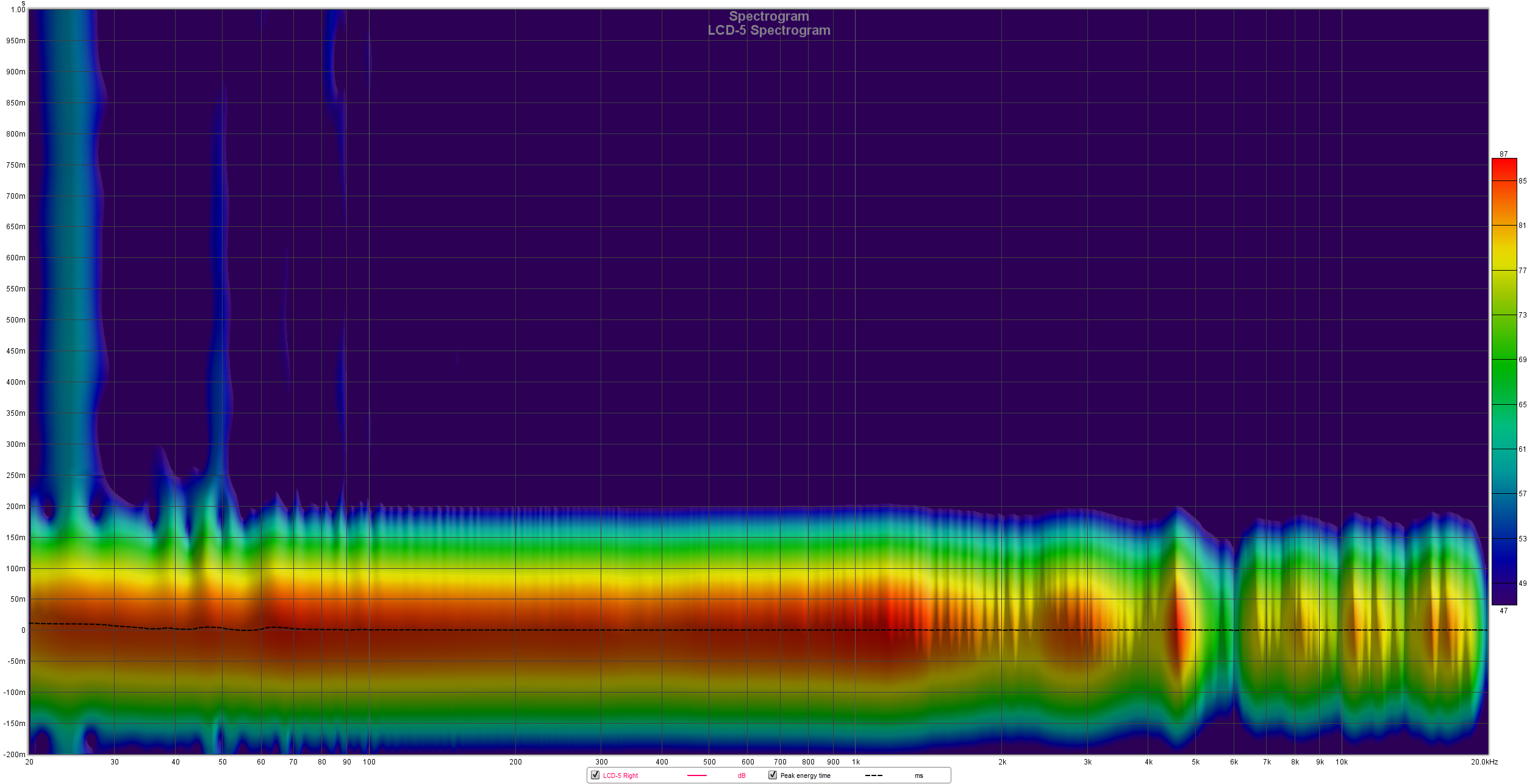
Spectrogram shows a minor ringing happening in between 20 and 30 Hz and another one at 50 Hz, but I don’t see nasty distortions building up anywhere else. I cannot hear that ringing in real life scenarios and you shouldn’t worry about this too much
Overall, I have recorded a much nicer frequency response (FR) to anything they’ve done before, it looks complete and extended versus their former flagships, there’s a low THD and the fastest decay I’ve measured so far. When it comes to measurements, LCD-5 is definitely flagship material!
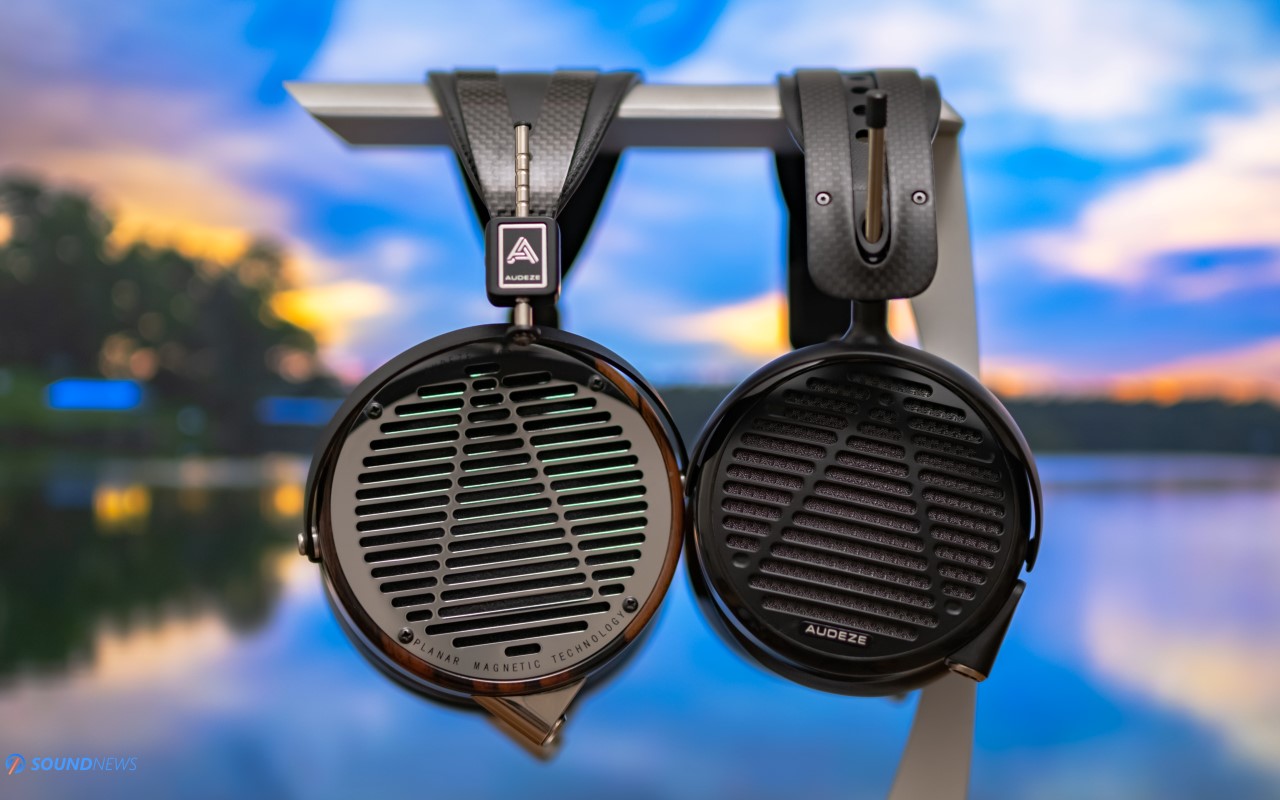
X. Comparisons
Since my whole review reads like a massive LCD-5 VS LCD-4 comparison, I decided telling you more about them.
A. Audeze LCD-5 ($4500) VS Audeze LCD-4 ($4000) – Discontinued
When it comes to build quality and looks, I find them impressive, but very different. You have an all-metallic structure with the LCD-4, huge ear-cups made out of hard woods, there’s a wide headband and massive looking leather ear-pads. For me, LCD-4 is the embodiment of boldness and nasty attitude, they look like a $1 million headphone. The only downside, which proved to be a massive one was their weight. Coming close to 700 grams or around 1.5 lbs., these will be crushing your skull after a few minutes of use. I don’t have a problem wearing them for longer periods of time, but I know people that can’t wear them for more than 30 minutes due to neck pain.
With LCD-5, Audeze cut 1/3 of the weight, while crafting a beautiful and long-lasting headphone. Its structure is much lighter now, incorporating magnesium, acetate cups and carbon-fiber on top. Their ear-cups are smaller, ear-pads are narrower and, in the end, we are getting a much lighter headphone that wouldn’t crush your neck. Do note that LCD-5 still offers a higher clamping force and on bigger heads, that might be a slight issue. Between you and me, I like the classy look of the LCD-4 a little bit more, but at the same time I can wear the LCD-5 more without discomfort and that’s what matters at the end of the day.
Sound wise, LCD-4 could be described as full-bodied, creamy and sweet sounding most of the time. They have a powerful bass delivery, an amazing sub-bass on desktop headphone amps, although they will sound better on a fully-discrete one. LCD-4 never tried to be linear, honest or ultra-revealing, mostly fun, always trying to make you feel great while listening to music. LCD-4 couldn’t be used in studios, as these weren’t that honest, linear or highly-resolving. On top of that, their low-sensitivity wasn’t greeted with open arms, as often times even dedicated headphone amps couldn’t drive them fully. All the newest amps don’t have such issues anymore, but in between 2015 and 2017…it was a challenge driving these beauties. LCD-4 were never perfect and we always knew their cons: they weren’t the fastest, nor the most detailed and transparent cans, beatifying and sugar-coating most tunes. With LCD-4, it felt like eating desert on breakfast, supper and dinner. They were lying to me, but those lies were so sweet and pleasant to hear. That’s exactly why LCD-4 are sitting on my headphone wall no matter what. I still find them unique and different to current production flagship cans and that’s why they will always remain in the family for a very long time.
LCD-5 have a similar taste, but it is a grown and a more refined one. Detail retrieval and transparency rocketed higher, so much so that LCD-4 feels muddy sounding by comparison. Fine details started appearing in so many tracks and I didn’t need to stress myself for that to happen. There is more happening everywhere in the FR, but especially in the treble, which felt clearer, more controlled and defined. On entry-level amps, LCD-4 were sometimes flabby and uncontrolled, a thing that never occurred with the LCD-5. The latest flagships were much faster and a lot more controlled down the road, regardless of the tunes that were playing in the background. LCD-4 mated well with ultra-fast and ultra-revealing amplifiers, hence using the Benchmark HPA4 for several years in a row, but LCD-5 no longer needs that, as they go fast and furious, without the need of a top-class amplifier. LCD-5 are much easier to drive and I can enjoy them even with USB type-C dongles like Shanling UA5 and FiiO BTR7, try doing that with LCD-4…it won’t work. Everything that was lagging behind on LCD-4, felt updated and pushed higher. While LCD-4 was only fun, LCD-5 is both fun and super-technical at the same time and the only things that LCD-4 are doing better are the soundstage and bass impact, which felt less impressive on the LCD-5.
If you already own the LCD-4, then LCD-5 will feel like a weird set at first, but a desirable one later on. I wouldn’t swap the LCD-4 with the newest headphone, I will try to own them both, as I find them so polarizing and different. If you care for measurements and technicalities, then sure enough, LCD-5 will be much better in every possible way.
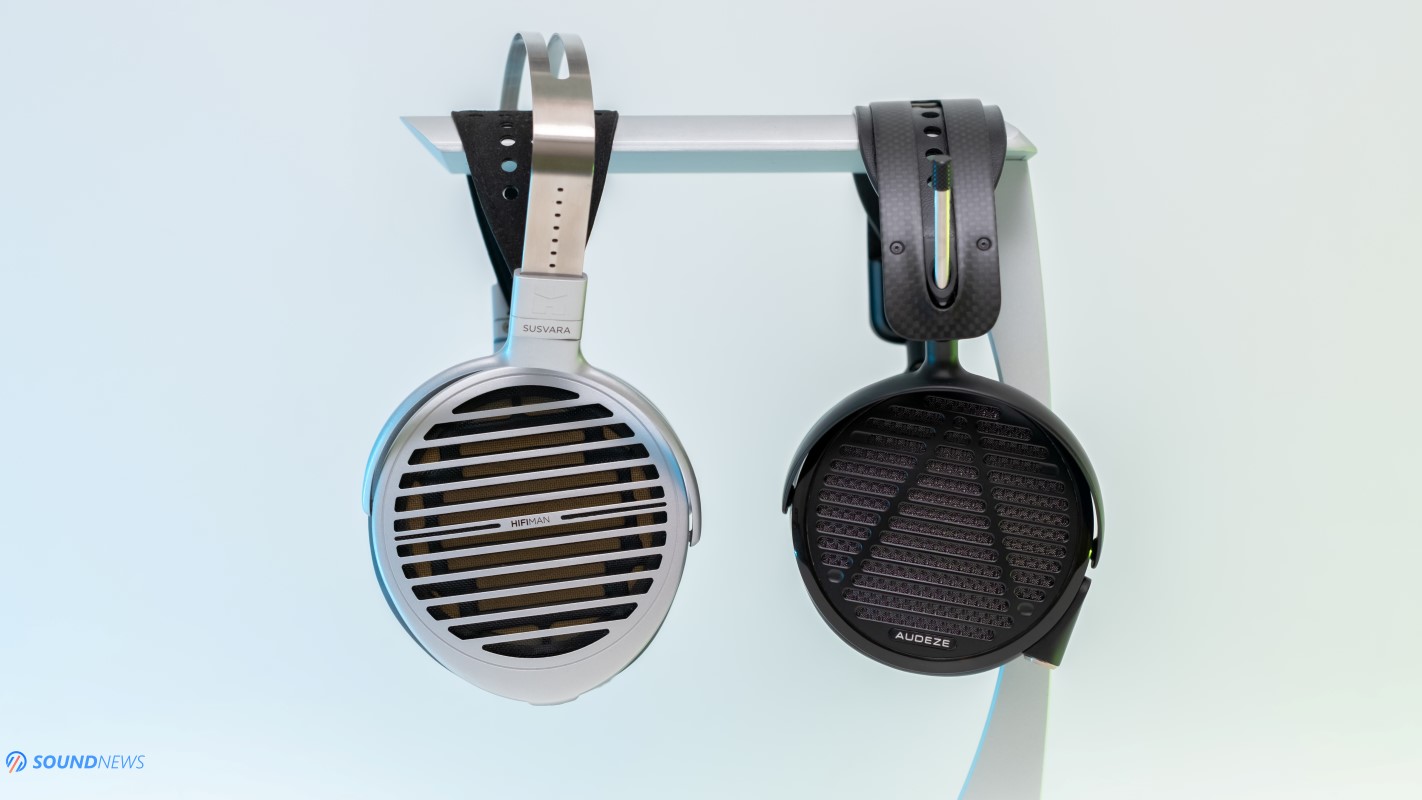
B. Audeze LCD-5 ($4500) VS Hifiman Susvara ($6000)
Oh boy, oh boy, now we’re talking! At least a few dozen people asked the same question via email and social media and I guess, I will be responding to them with a must-read comparison.
First things first, please consider their price points, as Susvara is a lot more expensive. Build quality wise, with all due respect to Hifiman, Susvara isn’t built at the same level as LCD-5 is. The steel frame is much thinner, the headband isn’t made from high-quality leather and the same can be said about their ear-pads. Don’t get me started with wooden veneers…I simply don’t like them and to me, Susvara doesn’t look like a $6000 headphone. With LCD-5, Audeze put a bigger accent on fine details, I find them sturdier, their ear-pads feel nicer and softer, their carbon-fiber headband is great looking , even their cups a nicer looking overall. There is one thing that Susvara does a little better and that is comfort, as there is less pressure on top and less clamping force to the sides.
Spec wise, both were blessed with the latest and the greatest tech, with one Major difference: Susvara is Much Harder To Drive. With an impedance of 60 Ohms and with a sensitivity of 83 dB, Susvara needs a little bit more power to my 120 pound-a-piece, KEF Reference 3 loudspeakers. If you think that I’m joking…that’s not really the case, as the same power amplifiers that are driving the Reference 3 are also driving the Susvara and I’m constantly getting less SPL from Susvara at the same volume position on my preamp. If a headphone amp will perfectly drive the LCD-5, there’s a big chance the same amp wouldn’t drive the Susvara, hence putting more than ~30 amplifiers in my Hifiman Susvara review. This is a very big deal, as thanks to the Hifiman Susvara, I needed to purchase the biggest and the heaviest current production headphone amplifier, the Trafomatic Primavera that was specifically designed with the Susvara in mind. LCD-5 could be enjoyed with almost anything, including with the newest MacBook Pro laptops that have beefier headphone outputs. Susvara on the other hand works with only a handful of headphone amps, integrated and power amps.
For all of the reasons combined, I decided comparing them on the Chord Dave DAC followed by the Trafomatic Primavera that will drive them both, with a lot of headroom remaining on tap. LCD-5 was so incredibly close to Susvara’s transparency and detail retrieval, but since LCD-5 have a less defined low-end, Susvara felt a tiny bit more extended and transparent sounding to me, but only when comparing them closely. When it comes to speed, I couldn’t tell which is faster, even if measurements were suggesting that LCD-5 were by a hair faster. They both got instant decays if the music was asking for it, both were tightly controlling their drivers. Double drums, snare drum hits and wild electronica tunes didn’t scare them away, as both were cruising at a constant, lightning-fast speed. Susvara isn’t known to be offering a huge soundstage, as their HE1000SE are sounding a little bigger and it seems that LCD-5 took the same course of action. I find them having an awesome imaging and a medium-sized stage, but Susvara took pe upper hand, getting a more holographic and spacious sound.
When it comes to frequency response, on one hand Susvara felt more complete as there’s a little more sub-bass definition and punch, on the other hand LCD-5 was more organic and life-life, always getting those harmonics right. On very rare occasions, Susvara could get a little hotter sounding, something that would never happen on the LCD-5. Their sound signature is more alike than different, as both were tuned with linearity and honesty in mind.
Overall, I find the LCD-5 easier to like and much easier to drive, these aren’t asking for nuclear-powered amplifiers and these are still cheaper by $1.5k. Susvara can get better, but only when driven by over-powerful world-class headamps or power amps, something that would be unnecessary with the LCD-5.
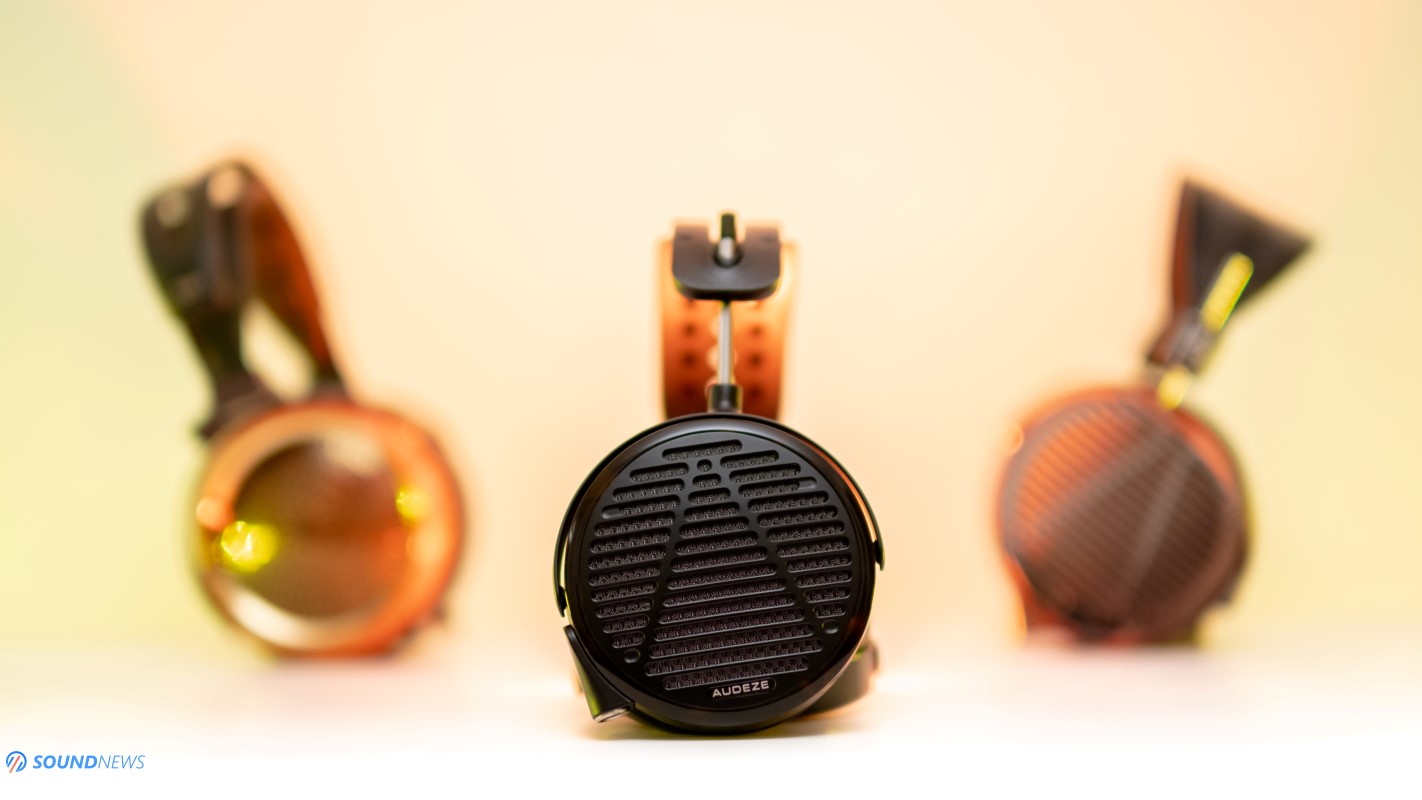
My Conclusion
I didn’t understand them at first and I’m not exactly sure if there’s any burn-in involved or maybe it’s my system that gets constantly updated, but in a few months…I could finally grasp their inner beauty and understand the message behind the LCD-5. People complained about lacking technicalities and high comfort levels before and it seems that both issues were addressed with a single headphone. I remember the shock when LCD-5 was revealed, looking with one eye if their price doubled as it happened before. Their asking price seems to be much lower to what I was expecting and I think it’s fully justified given their excellent subjective and objective performance. I can only nitpick about a gentler sub-bass delivery and less than perfect scale and depth, other than that, we are looking at the newest Audeze house sound, finely polished for the newest market demands and it’s my pleasure awarding them with a well-deserved Silver Award!

Their higher sensitivity and lower impedance planted a sprinkle of hope and it seems that AC powered desktop rigs are no longer required to enjoy a flagship headphone, as even USB dongles, Bluetooth gizmos and portable digital audio players were providing a tremendous satisfaction with a pair of LCD-5 on my head.
In the end, I believe the final question isn’t going to be if LCD-5 are amazing or not, but are they amazing enough to justify their asking price? That’s a question that you should address yourselves.
If everything I’ve said resonated with you, then prepare a nice gift for you lady first and then proceed to Audeze’s web-store right here. You can get them from your local Audeze dealer as well, you can find the nearest one right here. In case you’re getting a pair, please don’t forget to leave a comment below and let us know how these are treating you.
PROS:
- Great packaging and selection of accessories
- A very different looking Audeze headphone and yes, that’s a plus
- Six months later these are still looking as new, suggesting a high-quality craftsmanship
- Lighter weight and a lot more comfortable in long listening sessions, given that you aren’t bothered by the clamping force
- Detail retrieval incarnate, these will be showing the truth behind your tracks
- Transparent, layered and quite airy sounding
- Speedy Gonzales of the headphone world, these will leave competitor headphones in the dust
- Great imaging / pin-point location of the notes
- Tightly controlled at all times, even while driven by low-powered amplifiers
- More linear and honest sounding versus the rest of the LCD line up
- High quality bass that’s fast and controlled
- Rich and organic midrange
- Clean and textured treble, without becoming harsh or tiresome
- Very technical sounding in all regards
- Excellent set of headphone measurements
- So much easier to drive
- While far from being affordable by any stretch of my imagination, these are some of the cheapest flagship headphones
CONS:
- Bass slam isn’t that impressive – could be improved with a few amps or with a mild EQ
- Soundstage and depth took a hit – could be improved with a few amps
- Not as fun sounding as the rest of the LCD line of headphones
ASSOCIATED EQUIPMENT:
- DACs: Chord Electronics Dave, Audiobyte HydraVox & HydraZap, Ferrum ERCO, Gold Note DS-10 PLUS & PSU-10 EVO, Gustard R26 Discrete, Topping DX7 PRO+
- DDCs: Musician Phoenix, Singxer SU-6
- DAPs: FiiO M17, M11 Plus ESS, M11S, Shanling M7, M6 Ultra, Hiby RS6
- Headphone Amps: Trafomatic Primavera, Trafomatic Head 2, Ferrum ERCO, Ferrum OOR + HYPSOS, Enleum AMP-23R, Burson Soloist 3X GT, Flux Lab Acoustics Volot
- Preamps: Musician Monoceros
- Power Amps: Benchmark AHB2 (x2), Burson Timekeeper 3X GT (x2)
- Loudspeakers: KEF Reference 3, Sound of Eden Crescendo UNO
- IEMs: FiiO FH9, FA9, FH7, Meze Rai Penta, Rai Solo, LittleDot Cu KIS, Hiby Crystal 6, 7Hz Timeless, Kinera Skuld & others
- Full-sized headphones: Audeze LCD-5, Audeze LCD-4, Hifiman Susvara, Hifiman HE1000SE, Arya Stealth, Sennheiser HD800S, Erzetich Phobos V2021, Phobos V2018, Erzetich Mania, Kennerton Rognir, Vali, Apos Caspian, Sendy Peacock, Apollo, HarmonicDyne Poseidon & others
- Interconnects: QED Reference (x2), Topping TCX1 (x2)
- USB Cables: Supra USB Excalibur (x2), Chord C-USB, Matrix Hi-Fi USB
- HDMI Cables: Supra 8K HDMI 2.1 (x2)
- Speaker cables: Kimber PR8, Audioquest Type4
- Power Cables: Isotek EVO3 Premier (x3), iFi Audio SupaNova (x2)
- Balanced Isolation Power Conditioners: PLiXiR Elite BAC1500 (stereo setup), Elite BAC400 (headphone setup)
